
THE INDEPENDENT NEWSPAPER SERVING NOTRE DAME, SAINT MARY’S AND HOLY CROSS
WEDNESDAY, OCTOBER 8, 2025 |


WEDNESDAY, OCTOBER 8, 2025 |
By Mara Hall News Writer
The Trump administration recently proposed a “Compact for Academic Excellence in Higher Education,” to Brown University, Dartmouth College, Massachusetts Institute of Technology, the University of Pennsylvania, the University of Arizona, the University of Southern California, the University of Texas at Austin, the University of Virginia and Vanderbilt University.
The compact “would require colleges to freeze tuition for five years, cap the enrollment of international students and commit to strict definitions of gender,” in addition to ensuring that their campuses are run in a manner that would not question
or give resistance to conservative ideas. In exchange, the administration would give the universities priority in receiving federal funding.
According to the Texas Tribune, the UT System board of regents chair Kevin Eltife is eager to engage with this compact, and UT-Austin has started reviewing the ways that gender identity is taught around campus in an effort to comply with the restrictions of this compact.
The other universities have not made public remarks on the offer.
Matthew Hall, the director of the Rooney Democracy Institute and professor of constitutional studies at Notre Dame, argued the compact was a “fascist” tactic.
“All fascist politicians adopt similar tactics, and one of the most important tactics
is to create a sense of unreality by undermining objective facts. Therefore, fascist politicians are threatened by independent institutions that are designed to distinguish fact from fiction: courts, independent government agencies, the press, scientists, and — of course — universities ... The compact being presented to universities is a blatant, unprecedented attempt by the executive branch to take control of public and private universities,” Hall wrote in an email to The Observer.
James Curry, a Notre Dame political science professor, clarified that using federal funding to shape university policy isn’t new. Similarly, President Barack Obama asked states to get waivers
A sexual assault incident was reported in a residence hall at Saint Mary’s on Friday at 11 p.m., according to an email titled, “Timely Warning Notification,” sent by director of campus safety Phil Bambenek on Sunday morning.
The College’s Title IX Office and the St. Joseph County Police Department are currently investigating the report, Bambenek wrote.
He added that the suspect is not a member of the tricampus community.
“The survivor of the assault reported that she had met the suspect through a dating app,” Bambenek wrote.
of contact information for safety and support, including law enforcement agencies, hotlines and on-campus resources for students.
Bambenek shared that students should reach out to the Belles Against Violence Office or Saint Mary’s Campus Safety Department with questions and concerns. Bambenek advised those with information regarding the incident to contact the St. Joseph County Police Special Victims Unit
This was the first alert of its kind that Saint Mary’s students received this academic year. During the 2024-25 academic year, students did not receive any email alerts of reported sexual assault. see “Universities” on page 2
The email included a list
By Maggie Powell News Writer
Working with the McDonald Center for Student Well-Being, Duncan Hall hosted its signature Jorts for Joey event on Friday, Oct. 3. This time around was the dorm’s third time hosting the event.
The first Jorts for Joey event took place in the spring of 2024, just months after the death of Joey Harris, who graduated from the University in the spring of 2023 and committed suicide in January 2024.
Preparations for the event, led by Duncan Hall health and wellness
commissioner Emerson Carella, began this past spring. Duncan Highlanders volunteered at the event by working the table, promoting mental health resources and assisting with jeans cutting.
Peer listeners and University counselors were also present at the event to provide information. Those who visited their booth could donate $10 to purchase a pair of jeans to cut into jean shorts, or jorts. The proceeds from the event benefitted Movember, a nonprofit dedicated to men’s mental health and suicide prevention.
Duncan Hall president Gabe
Angaiak spoke to the event’s significance.
“It’s more than just raising money for mental health through Movember. It’s in remembrance of a guy that really stood for what Duncan Hall was,” Angaiak said.
“He was a great guy. Everyone in the dorm loved him. He’s the type of dude that started a culture in Duncan Hall … You just have an open heart, and that’s who Joey was. I feel like this event really remembers that about Joey and instills that into Duncan Hall, even
see “Jorts” on page 4

NEWS | PAGE 3
Hispanic heritage
ND’s Institute for Latino Studies will host events to celebrate Hispanic Heritage Month.
OPINION | PAGE 5
Off the Dome
Columnist Allison Elshoff highlights Victoria Nyanjura’s journey from Uganda to ND.
SCENE | PAGE 7
Taylor in trouble
Swift’s new album, “The Life of a Showgirl,” started strong, but sadly, it continued.
By Lucy Loes News Writer
On Tuesday afternoon, the Kellogg Institute for International Studies and the Klau Institute for Civil and Human Rights hosted Michele Waslin, who holds a Ph.D. in government and international relations from Notre Dame, and her co-author Carol Cleaveland to discuss their book, “Private Violence: Latin American Women and the Struggle for Asylum.” The lecture was part of Graduate Student Appreciation Week.
The authors spoke about how the U.S. asylum system fails to protect Latin American women seeking gender-based asylum because the current legal system requires persecution to come from state actors rather than private individuals. They emphasized the resilience of both asylum-seekers and their advocates.
Cleaveland began research for the book when she was asked to ascertain the credibility of female Latin American genderbased asylum-seekers through psychological assessments. She
SPORTS | PAGE 11
ND women’s soccer No 2. Notre Dame prepares to host No. 5 Florida State in a battle of unbeatens.
interviewed 46 women whose stories inspired her to seek Waslin’s help in creating their book.
“I was hearing these really unbelievably terrible stories from women from El Salvador, Honduras, Guatemala [and] Mexico about what had happened to them that had forced them to come here to seek asylum. They described gang rapes by gang members,” Cleaveland said. “They described horrific gender-based violence and extortion threats … Then I started observing what happened in their court hearings, and those were very compelling moments, because I saw how difficult the journey is to convince an immigration judge that you meet all of the criteria to win asylum in the United States.”
The U.S. asylum system doesn’t consider domestic or private violence to be a form of persecution. Waslin believes this stems from the original intent of the refugee system, which was designed to protect a limited number of people
SPORTS | PAGE 12
Football grades
The sports staff hands out a report card to Irish position groups following week six.

ndsmcobserver.com
“TO UNCOVER THE TRUTH AND REPORT IT ACCURATELY”
900 Hesburgh Library, Notre Dame, IN 46556
Editor-in-Chief
Liam Kelly
Managing Editor Gray Nocjar
Asst. Managing Editor: Aynslee Dellacca
Asst. Managing Editor: Grace Tadajweski
Asst. Managing Editor: Henry Jagodzinski
Notre Dame News Editor: Sophie Hanawalt
SMC News Editor: Berhan Hagezom
Opinion Editor: Redmond Bernhold
Sports Editor: Noah Cahill
Scene Editor: Peter Mikulski
Photo Editor: Mariella Taddonio
Graphics Editor: Isabelle Rutland
Social Media Editor: Duncan Stangel
Ad Design Manager: Isabelle Rutland
Business Manager: Zack Pohlman
Systems Administrator: Jack MapelLentz
Advertising advertising@ndsmcobserver.com
Editor-in-Chief lkelly8@nd.edu
Managing Editor gnocjar@nd.edu
Assistant Managing Editors adellacca01@saintmarys.edu, gtadajwe@nd.edu, hjagodzi@nd.edu
Business Manager zpohlma2@nd.edu
Notre Dame News Desk shanawal@nd.edu
Saint Mary’s News Desk bhagezom01@saintmarys.edu
Opinion Desk rbernho2@nd.edu
Sports Desk
ncahill2@nd.edu
Scene Desk pmikulsk@nd.edu
Photo Desk mtaddonio01@saintmarys.edu
Systems & Web Administrators webmaster@ndsmcobserver.com
Policies
The Observer is the independent, daily newspaper published in print and online by the students of the University of Notre Dame du Lac, Saint Mary’s College and Holy Cross College. Editorial content, including advertisements, is not governed by policies of the administration of any institution. The Observer reserves the right to refuse advertisements based on content.
The news is reported as accurately and objectively as possible. Unsigned editorials represent the opinion of the majority of the Editor-in-Chief, Managing Editor, Assistant Managing Editors and department editors. Commentaries, letters and columns present the views of the authors and not necessarily those of The Observer. Opinion space is available to all readers. The free expression of all opinions through letters is encouraged. Letters to the Editor must be signed and must include contact information.
Questions regarding Observer policies should be directed to Editor-in-Chief Liam Kelly.
Post Office Information The Observer (USPS 599 2-4000) is published Monday through Friday except during exam and vacation periods.
A subscription to The Observer is $130 for one academic year; $75 for one semester. The Observer is published at 900 Hesburgh Library Notre Dame, IN 46556-0779
Periodical postage paid at Notre Dame and additional mailing offices
POSTMASTER Send address corrections to:
Corrections
The Observer regards itself as a professional publication and strives for the highest standards of journalism at all times. We do, however, recognize that we will make mistakes. If we have made a mistake, please contact us at editor@ ndsmcobserver.com so we can correct our error.
By Samantha Gebert News Writer
On Friday, in advance celebration of the feast day of St. Francis of Assisi Saturday, the Saint Mary’s Center for Faith Action and Ministry and Sustainable Farm held their annual Francis Fest.
Senior Mary O’Connell, one of the Sustainable Farm’s student leaders, shared that she felt this year’s event was a success and noted that there were about 150 people in attendance.
Students gathered at the Sustainable Farm from 4:45 p.m. - 6 p.m. for a spicy pepper eating contest and other activities organized by student farmers and volunteers, including a photo booth with chickens and pumpkin
painting with farm-grown pumpkins. Attendees also got to witness the blessing of the farm.
Explaining the popularity of the chicken photo booth, O’Connell wrote in a statement to The Observer, “The SMC chickens are well-loved by the community, and they are an important part of our mission.” She described the chicken’s role in eliminating food waste from the dining hall, as they compost the waste.
O’Connell said she believes the event helps connect the broader SMC community with the farm.
“Francis Fest is important to the SMC community because it gives us an opportunity to connect the work of the Sustainable Farm with the mission of Saint Mary’s College,” she wrote, adding, “It gives us the opportunity to connect with community members that might not otherwise be
involved at the farm, as well as to share about the work that we do and the mission behind it.”
Junior Kimi Ortiz echoed O’Connell’s sentiment, writing in a statement to The Observer that “Francis Fest is a fun event to build community at SMC while bringing people to the farm.”
In addition to connecting the community, the event honors Francis as the patron saint of animals and ecology. “The Farm is such a unique and special part of Saint Mary’s, especially our chickens and Francis Fest brings attention towards not just the farm and the chickens but the community the CFAM office brings. It’s a time to reflect on the beauty of creation and a blessing towards our chickens since St. Francis is the patron saint of animals,” Ortiz wrote.
Ortiz, who volunteered at the
event, appreciated its variety of activities. “There is something for everyone, whether it’s eating spicy peppers, painting pumpkins, having some food, or meeting some chickens.”
Ortiz particularly enjoyed the spicy pepper eating contest, which O’Connell started three years ago. “We were trying to figure out how to deal with an abundant harvest of peppers, and I made a joke in a meeting that we should hold a contest for people to eat all the peppers. While I thought it was just a oneoff joke, apparently the rest of the staff took it seriously, and it now has started a tradition that will hopefully continue on even after my time at the Sustainable Farm is over,” O’Connell wrote.
Contact Samantha Gebert at sgebert01@saintmarys.edu
By Isabella Ponciroli News Writer
The Notre Dame and Saint Mary’s Ballroom Club gathers student dancers of all skill levels for competitions, campus performances and regular practices. The group meets to practice on Monday, Tuesday and Thursday nights from 8:30 to 10 p.m. in either the Rockne Memorial or the Smith Center to practice a variety of dancing styles.
Emma Stadelmann, a graduate student at Notre Dame and the club’s secretary, explained that the club is open to dancers of all skill levels. With this, Mondays’ practices throughout the school year are dedicated to the club’s officers teaching other students,
Continued from page 1
from No Child Left Behind before they could receive federal education funds.
“This is an attempt by the president to do what presidents often try to do, but it is in a seemingly more targeted, less bureaucratic way of trying to use what leverage he has over the expenditure of federal funds to try to shape policy the way that he wants,” Curry said.
Alex Funk, the co-political director of College Democrats, said the compact is an effort to limit academic freedom.
“The administration is holding universities hostage and assaulting free speech in the process. Donald Trump is testing these universities to see how far he can go in demanding loyalty from institutions around this country,” she wrote in an email to The Observer.
In light of these concerns, Funk asked universities to “stand up to this extortion attempt.”
She wrote she hopes “that Notre Dame has a spine and
catering towards beginners. On Tuesdays and Thursdays, coaches provide professional instruction and work on advanced technique with dancers.
“We do a progressive series of classes, where we do three different weeks that are all on the same dance,” law student and club vice president Dan Mohr said. “That way, somebody can come in, start with that dance and then have something to build on week after week.”
The club practices all American and international styles of dance that are open to competition in the ballroom circuit, including waltz, tango, foxtrot, cha cha, swing and quickstep. Dance styles are taught in blocks of two every three weeks.
The club travels to multiple competitions per year at other
continues to stand up for the best interests of our community.”
College Republicans declined to comment, writing they had not studied the topic at this time.
While Curry declined to make recommendations as to how universities should navigate Trump’s request, he did note that he thinks schools are likely to oblige to the demands.
“Past recent history suggests that they will agree to what is offered to them as long as they think it will mean that it puts them in a better financial situation,” he said.
Hall also pointed to lessons from history as an indication of how the request will play out, but he warned that “universities that hope to appease the administration by agreeing to this compact will be sorely disappointed.”
He continued by writing, “The fate of academic freedom in this country is likely tied to the broader struggle against these fascist political tactics that have similarly targeted independent agencies (like the Bureau of Labor Statistics), news organizations (like the New York Times), media outlets (like ABC and Jimmy Kimmel), private business (like prominent law firms), and any institution in society that refuses to bend the knee.”
As conservative Americans lose
universities including Purdue and Northwestern. They also host their own competition, the Irish Dancesport Gala, on campus in the spring.
Club members of all skill levels are encouraged to compete at the competitions, where club officers match dancers to their partners.
On campus, the club performs with groups such as Troop ND and at events like Art Attack. The club also has a social dance each semester.
Last year, the group performed with the South Bend Symphony Orchestra, where they danced a Viennese waltz feature for the “Waltzing with Strauss” concert.
Sophomore Gabriel Ortner shared how he uses his ballroom dance skills outside of the club.
“It’s very useful for things like
trust in higher education, Curry said universities are becoming more skewed towards Democratic voters. He argued repairing this distrust requires reform on multiple levels.
“Universities are going to have to try to navigate where they try to rebuild broader support for what they do, their mission and how they function,” he said. “That is going to require a bit of a mix of changes to public policy and some internal reforms taken on by the part of the universities themselves to better market themselves and present themselves to different swaths of society in a way that they sort of have not in the last couple decades.”
Relying on federal funds can be dangerous for universities, Curry said, as the funding is often subject to political pressure. “It has always been dangerous, in my view, for universities to be reliant on any federal funds to function because it is always somewhat precarious,” he said.
As to the specifics of the Trump Administration’s requests, Curry cited concerns that forcing international students to seek degrees outside of the United States will strengthen the technological skill and work force of our competitors.
“If we make it harder for [the best and brightest] students to come
dorm dances, SYRs and weddings. I know how to dance other than just jumping. There are tons of dance situations out there, both in and outside of college that this prepares you for,” Ortner said.
Monica Levis, another sophomore, emphasized her love for the community she has found through the club.
“I have made so many friends here, and the people are really lovely. And there is something of a bonding experience going to a competition. You’re in the car with people forever. You’re sleep deprived and tired. But, you’re all here for the same reason: genuinely, a love of dancing,” Levis said.
Contact Isabella Ponciroli at iponciro@nd.edu
here, that is going to advantage the abilities of universities in Asia or in Europe, which are the primary competitors for American higher education,” Curry said.
Since it doesn’t have a medical center dependent on large National Institute of Health Funding grants, Notre Dame is less reliant on federal funding. However, Curry noted that Notre Dame suffers more than others when endowment tax regulations tighten due to the large size of its endowment.
In April, Notre Dame President Fr. Robert Dowd signed the “Call for Constructive Engagement” condemning administrative overreach of higher education. When asked whether the compact is in conflict with the call, Curry declined to answer, saying that he hasn’t read the initiative recently. Hall declined to answer the question.
Notre Dame declined to comment on the topic of the University Compact. “While we appreciate the opportunity to respond, we cannot possibly speculate on such a hypothetical,” University spokesperson Erin Blasko wrote in an email to The Observer.
Contact Mara Hall at mhall27@nd.edu
By Maria Alice Souza Maia News Writer
From Sept. 15 to Oct. 15, the Institute for Latino Studies has hosted a series of events to celebrate Latino culture as part of Hispanic Heritage Month.
One of those events, held this Monday in Bond Hall, was “Audacious Compassion: Poetry from Summer 2025.” The event was coordinated by Karen Richman, the institute’s director of undergraduate studies.
“This is an event featuring poetry [written by] students in my summer class, which accompanies the service component of the cross-cultural leadership program,” Richman said.
Students in Richman’s class were asked to respond to assigned films and readings in either a standard or creative format. “The weekly reflection could be in a standard essay form in response to assigned films or especially readings, or it could be in a creative format including poetry, photo essays, fiction or music. The students took the creative option many times,” Richman said.
Impressed by the quality of her students’ work, Richman
created the event as an opportunity for them to share their poetry. “The poems were so profoundly moving and personal, especially in the context of what was happening this summer, the persecution of immigrants. And then I felt I shouldn’t be the only reader of this poetry. So I organized this event and all seven of the students are going to participate,” Richman said.
Professor Francisco Aragón, the director of “Letras Latinas” at the Institute for Latino Studies, explained the institute’s mission to recognize and understand the Hispanic community. “The Institute for Latino Studies was founded at Notre Dame in 1999. And one of the reasons why the Institute was founded is that the University recognized that the Hispanic community is perhaps the fastest-growing community among Catholics,” he said.
The University’s response to this growth “was to create the Institute for Latino Studies in order to better understand this community across disciplines,” Aragón said
In addition to the Hispanic Heritage Month events, Aragón explained that “the Institute tries to offer courses and
cultural events all year round to try to illuminate the US Hispanic experience in many different areas.”
Aragón reflected on Hispanic Heritage Month activities that took place earlier in the month, including an event with Wisconsin poet laureate Brenda Cárdenas.
“[Cárdenas] gave a very special presentation at the museum in which she talked about poetry inspired by visual art and gave examples of her own poetry. We had very robust attendance, close to 100 people attending. Nearly all the seats in the atrium were filled,” Aragón said.
Jason Ruiz, the director of the ILS, said the event demonstrated the institute’s commitment to the arts.
“ILS was thrilled that one of our flagship programs, Letras Latinas, is partnering with the Raclin Murphy Museum to bring Brenda Cárdenas to campus. We can’t seriously study the Latino experience in the United States without consideration of Latino contributions to the arts,” he said.
In addition to Cárdenas’s talk, the Institute hosted a musical performance by anthropology
Doctor of Nursing Practice
Geriatric Neuropsychiatry Certificate
Master of Science in Nursing
Master of Social Work
Master of Science in Speech-Language Pathology
Master of Data Science (3+1 and 4+1)
professor Alex Chávez. “Another event I want to point out is one that happened recently on Oct. 2. It was at the DeBartolo Performing Arts Center, and it was called Sonorous Present, Songs of Border Crossings, Sunrises and Mornings,” Aragón said. “[Chávez] was performing with a musical group called Quetzal. What was important about that event was that he was combining his scholarly research with music.”
Chávez’s music was inspired by his family, “who migrated to the United States from Mexico when they were teenagers. It was also a very moving performance about expressing grief for the loss of loved ones,” according to Aragón.
Aragón also highlighted upcoming events leading up to the conclusion of Hispanic Heritage Month. “This coming Wednesday, we’re going to be having another event that’s going to feature a postdoctoral fellow here at the ILS. Her name is Maryam Parhizkar, and she will be giving a talk about her current scholarship,” he said.
On Oct. 12-13, the Institute is inviting Latino clubs and organizations to participate in its
Ofrenda Making event. Clubs and individuals can create and display an “ofrenda” (altar) in the ILS lounge. The event is “to celebrate those loved ones who have passed away, which is a lead-up to Day of the Dead, which is actually at the end of October, after Hispanic Heritage Month. But that is also a very popular event that we do,” Aragón said.
Aragón clarified that students “do not have to be Latino to major in Latino Studies or minor in Latino Studies” and reminded them that understanding the Latino community is beneficial to many careers.
“The argument that we like to make is that whether you’re going into pre-med or pre-law or business, it’s important to understand this community, whether you’re studying this community through history, political science, literature or art,” Aragón said. “The broader knowledge you have of this community, regardless of what area you’re focusing on, will help you in whatever career you pursue.”
Contact Maria Alice Souza Maia at msouzama@nd.edu

With a variety of options to choose from, you’ll have plenty of opportunities to explore campus and discover why graduate programs at Saint Mary’s College are right for you.
You’ll have the opportunity to hear from members of the Office of Graduate Admission and Student Financial Services, take a tour of campus, and see academic centers and labs. Lunch will be hosted by current graduate students, and your day will end with a visit to your specific graduate studies department where you’ll meet faculty and staff.
Friday, October 10
Friday, November 7
All prospective graduate students who attend an on-campus visit (regular daily visit with our team or an event) will earn a one-time $1,000 award added to their graduate financial aid package if they enroll. PAID ADVERTISEMENT
In these program-specific virtual sessions, faculty from your department of interest will provide a short presentation followed by a Q & A session. A member of the Graduate Admission team will also be there to answer any admission or financial aid questions.
Visit the Register Today QR code for information regarding session dates and times.
If you can’t attend any of these visit days, we invite you to request a virtual or on campus visit.
Continued from page 1
fleeing from authoritarian or communist regimes, not large numbers of people looking for protection from non-state violence.
However, Waslin argues that the idea of private violence is misleading. “One of the points that we made in really great detail throughout, especially the first part of the book, was the social context that sent women who were suffering gang and domestic violence fleeing to the United States. And that was the fact that in all of these countries there was a great deal of political destabilization,” Waslin said. “There really is no such thing as private violence, right? All of this
Continued from page 1
now that he’s passed.”
According to Duncan residents, Harris was known for wearing jorts with his green blazer every Friday before a home game. His act of inviting his section to cut up their jeans to wear together at the beginning of the school year served as the inspiration for the event.
violence takes place because of public and state factors.”
As a result, Latin American women fleeing gender-based violence face many obstacles in receiving asylum. The coauthors explained how, in court, asylum-seekers need to prove that they fall into a specific, recognized social group, that they were persecuted because of that social group, and that their country fails to offer protection. On top of that evidence, they need to prove their credibility, which language and cultural barriers often make difficult.
No matter their reasons for crossing the border, many asylum-seekers are treated as criminals. “[The] consistent message, I think, that the American public hears is that these people are frauds, that
This year, Harris’ phrase, “Love you, brother,” was inscribed in Duncan freshmen’s green blazers to commemorate Harris.
Elio Carella, a former Duncan Hall resident and 2024 University graduate, lived in the same section as Harris for multiple years. He shared that the hall was in disbelief after hearing news of Harris’ death and emphasized their resolve to “do something” in honor of someone who did so much for Duncan Hall.
they are trying to gain their way into the country, that they’re trying to change the system, that they’ve received very specific instructions for what to say and how to get into the country,” Waslin said.
Waslin refuted this idea, saying that “the women we spoke to knew nothing of the sort, but they were literally fleeing for their lives in the middle of the night.”
Since their book was written before the 2024 presidential election, the co-authors wanted to contextualize it in light of recent political developments.
“Unfortunately, it seems so quaint those little ideas that we had for fixing the system, because so much has changed. Right, in the first Trump administration, they made it very clear that they had no interest
Elio Carella recalled how the hall’s rector took initiative by “funding a project to make a special bench and memorial outside the dorm for Joey,” making known the mental health struggles Harris faced before his passing.
“There is a stigma behind [mental health], and it’s unfortunate. That’s why I think that it’s so important, because I don’t think people should be afraid to talk about it,” Elio Carella said. “That is one of the big things about Duncan: That
in asylum generally and very specifically, gender-based cases. They completely shut the door on gender-based cases and made it clear that private violence was not a criteria for asylum,” Waslin said.
Waslin also expressed concern about the way women are treated if they are detained by United States Immigration and Customs Enforcement. “We know that pregnant women are being forced to give birth in detention. They’re being separated from their children. I’m very concerned, but I’m also concerned about what is happening to U.S.born American citizen women in this country under this administration. I think that they are starting with foreign-born women, because that is an easier target, but I think that
the guys in there could always help each other … and work together.”
According to Elio Carella, Harris is remembered as “very welcoming, happy and enjoyable to be around,” with Duncan residents remembering Harris as always having his door open and inviting people to come in and chat. Duncan Hall’s motto is ‘Brotherhood, Community and Respect,’ which Elio Carella noted Harris embodied.
“He wanted everyone to feel
they’re coming for all women,” she said.
Despite these concerns, Cleaveland is hopeful that anger surrounding immigration policies can be harnessed. “I think people are getting really upset seeing people working on someone’s lawn and being dragged away. I think we can build on that, and I think we just need to talk to people. I think we need to get the vote out in the next election,” she said.
“We’re going to have to just keep the faith and keep going until there is lightness. Luckily, we’ve survived dark periods in history before, but Michele’s right, this is an ugly time,” Cleaveland said.
Contact Lucy Loes at lloes@nd.edu
a part of the dorm … and I think that’s what the Duncan Hall motto is about,” he said. “Joey treated every person that he interacted with like they were family … If I were to choose a handful of people in both my and his class, I would say he’s definitely one of the top people that could have represented the dorm and what it stands for … He was able to bring people together.”
Contact Maggie Powell at mpowel25@nd.edu
Wednesday, October 8
12:15 - 1:45 p.m.
Experience Korean Flavors: Food Tasting Jenkins Nanovic Halls Forum
2:00 - 5:30 p.m.
Maedeup - Traditional Knot Tying with Artist Karen Ahn
1030 Jenkins Nanovic Halls (Registration required)
6:30 - 8:00 p.m.
Concert featuring the Korean Performing Arts Institute of Chicago and ASCEND Washington Hall
Thursday, October 9
1:00 - 3:00 p.m.
Culture Booth: Games, Costumes, and Souvenirs On the quad east of Jenkins Nanovic Halls
6:30 - 9:00 p.m.
Film Screening of Mal-Mo-E: The Secret Mission Browning Cinema, DeBartolo Performing Arts Center
Friday, October 10
7:00 - 10:00 p.m.
ASCEND Festival Hesburgh Library Lawn


By
Her infectious laughter fills the air, and the rest of us can’t help but smile too. I’m standing on Library Lawn with Victoria Nyanjura, who has just spent two days traveling from Uganda to South Bend. Given the arduous journey, one might be surprised to find the native Ugandan mingling and eating raspberry ice cream late on a Tuesday night – much less agreeing to participate in a fireside chat with me. But those who know Nyanjura well also know that she will make time for anyone.
This time, it’s for the students of Notre Dame’s Innovation For Impact (I4I) club. The club works with St. Bakhita Vocational Training Center (SBVTC), a school in Kalongo, Uganda that provides women training in vocational and entrepreneurship skills. The school was initially founded in 2007 to educate girls affected by the Lord’s Resistance Army (LRA) conflict and has grown significantly since partnering with Notre Dame’s Wendy Angst, a professor in the Mendoza College of Business’s Management and Organization Department in 2020. Under the helm of Nyanjura as their head of school, and with the support of Wendy’s innovationfocused courses, St. Bakhita has graduated over 150 “Innovation Scholars” and has also become the ‘proofof-concept’ for the Powerful Means Initiative (PMI) at Notre Dame. The I4I club is one way Notre Dame students can engage in work with St. Bakhita. Given that most club members have never traveled to Uganda, getting to meet Victoria at this ice cream social is special: it’s a reminder that their semester-long projects have an actual, tangible and real-world impact. Nyanjura settles quietly into her chair as we climb up on stage to begin the questions, her modest composure hiding the fact that she is likely the most impressive woman I’ve ever met. It’s a privilege to get to retell her story here.
Nyanjura was born in northern Uganda, in a small district named Oyam. It is also where, at the age of fourteen, she was abducted by the LRA. The LRA was formed by Joseph Kony in 1987 as a religiously-inspired militia group. According to the United Nations, the group was responsible for more than 100,000 deaths, the abduction of up to 100,000 children and the displacement of as many as 2.5 million civilians between 1987 and 2012. They used child abduction as a primary recruitment method,
forcing victims to serve as child soldiers and sex slaves.
Such was the case one night in 1996, when LRA soldiers captured 139 girls from St. Mary’s College Aboke. A school nun was able to negotiate the release of most of the young women, but Nyanjura, who was attending the school at the time, was not among those released. Instead, she would go on to spend eight years in captivity.
“Life in captivity was horrible,” she recalls. “We had … sometimes nothing to eat, many people died of thirst. There was no water, especially in South Sudan … many people died because they were killed or escaping.”
During those eight years, Nyanjura was assigned as a wife to a rebel commander and had two children. “Many young girls, under the age of ten, too, were abused sexually. They were given no medical attention because there was no professional doctor. One [time] I was flogged … My bumps were swollen – I couldn’t sit, I couldn’t do anything. I thought of committing suicide, but I couldn’t even do it because I was surrounded by so many people.”
The LRA claimed to be a Christian movement, but there was clearly no God in their actions. It makes it all the more impressive that Nyanjura, raised by a Catholic family and abducted from a Catholic school, was able to draw strength from her faith.
“I continued to recite my rosaries as we moved from one place to another. I later learned that … my family also started reciting rosaries every day … calling upon Mother Mary to keep me safe and bring me back home … That made it very possible for me to stay strong. I’m grateful to God for that.”
Captives were usually told that escape was impossible and that their only option to stay alive was to follow their commander’s order. Those who attempted escape were often killed as a deterrent to others.
Yet, Nyanjura’s prayers would be answered on a rainy night in 2004, when a fight between the rebels and Ugandan government finally gave her an opportunity to slip away. She explains how, carrying her son and daughter in her arms, the rain made their escape possible:
“After the eight years, God listened to my prayers … Another lady near me also had a child – we looked into each other’s eyes and … agreed to [leave] without letting anyone know … Thirty minutes down the road, heavy rain started [that covered our tracks] ... We started walking toward the dawn with fear
that the LRA would shoot us ... But God was great: the LRA people didn’t find us.”
She eventually came across government soldiers who took her to a nearby city to be reunited with her parents. After eight years, she finally returned home, grateful to be welcomed back by her village and begin the “long journey to healing through struggles.”
Nyanjura wanted to find a way to turn her painful experience into something positive. For her, this meant taking back something she had been robbed of in captivity: an education.
Returning to school would pose its own challenges, though. “School was not easy,” she says. Nyanjura had been lucky to be welcomed back to her community, but many families were ashamed to take back their victimized children. Often, kidnapped women were referred to as “the broken girls” – reflecting society’s view of them upon return as sexually impure or spiritually tainted “outsiders.” For Nyanjura, leaving her village would mean subjecting herself to stigmatization by classmates and others.
Undeterred, Nyanjura convinced her father to let her return to high school. After graduation, she thought she would pursue her dream of being an engineer. Yet, the feeling of empowerment she gained while in school called her to help other women who had gone through the same thing she had. So Nyanjura pivoted, earning her degree in development studies instead from Kyambogo University and joining an NGO to help other women transitioning from captivity.
At work, she met interns from the Kroc Institute for International Peace Studies who encouraged her to apply to graduate school at Notre Dame. She applied and was accepted – graduating from the University with a master’s in international peace studies in 2020.
During her time at Notre Dame, Victoria was contacted by Mendoza professor Wendy Angst for a coffee chat. Nyanjura learned that Angst wanted to partner with a struggling school in northern Uganda – SBVTC – for her “Innovation and Design Thinking” class that Fall. After seeing her story in a campus paper, Angst was hoping that Nyanjura could provide knowledge and expertise to help advise the class.
“We talked casually,” Nyanjura says when recalling their first meeting. “But I could see the vision [Wendy] had. She saw the need to revive the school and give opportunity to young girls to get quality education,
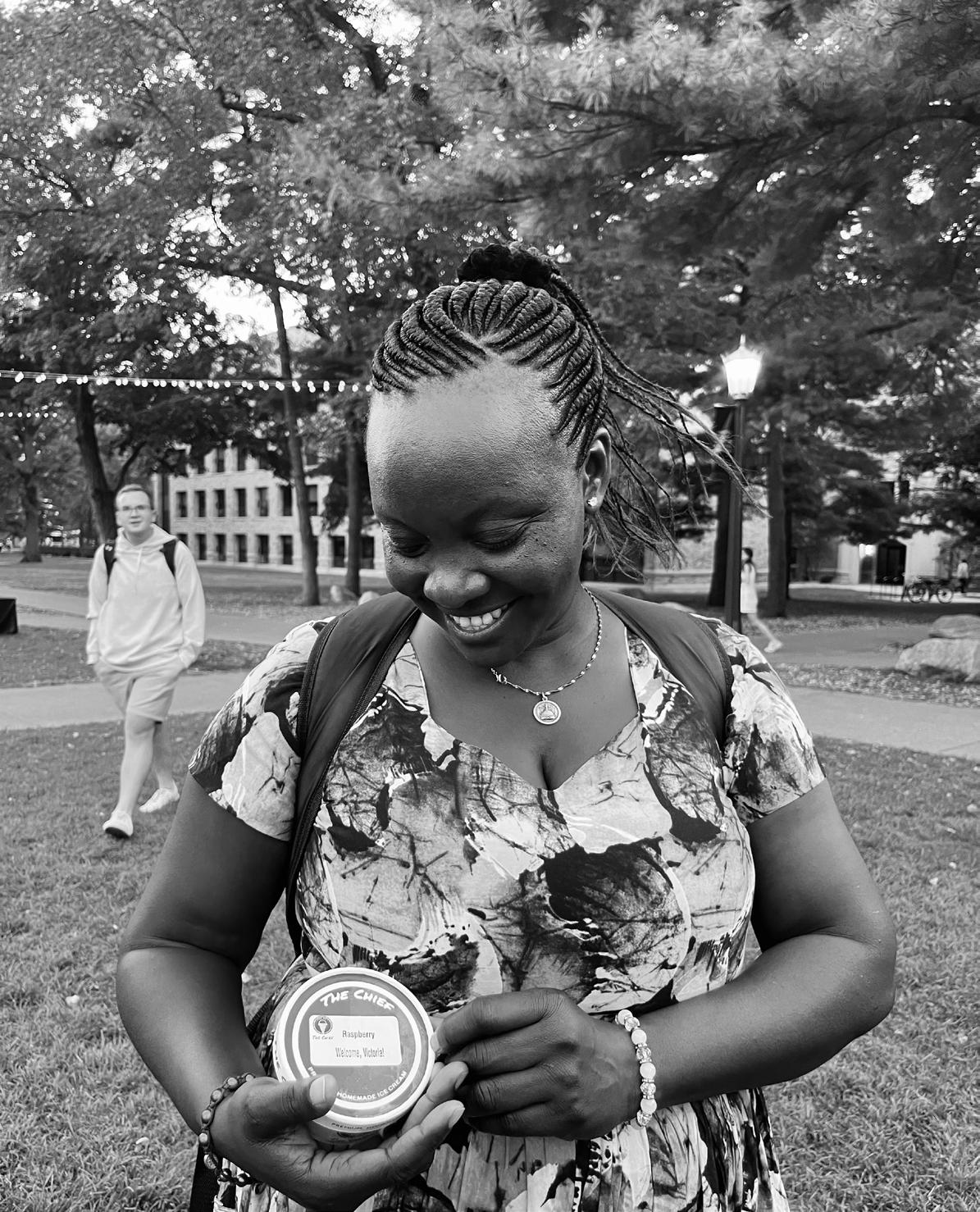
to have opportunity, to have a place to call home.”
After the semester came and went, Angst decided to keep working with St. Bakhita, establishing a partnership to mutually enrich the students’ education at both Notre Dame and SBVTC. She wanted to tackle a new project related to the school and community each semester – and the class’ popularity skyrocketed.
As St. Bakhita gained momentum, Angst asked Nyanjura if she was interested in being their head of school.
Nyanjura was hesitant. But education is what had given her “new life and purpose,” and the chance to extend that opportunity to more girls was something she could not pass up.
Today, Nyanjura spearheads work with Notre Dame and St. Bakhita as a part of a powerful partnership between the two schools. Along with producing 156 graduates, the school also runs an Early Childhood Development Center, has planted 20,000 trees at “Innovation Acres” and has launched seven revenue-generating microbusinesses in the community.
“We are grateful that we have been able to touch so many young women who did not have hope,” Nyanjura says. “To have hope for education, to have an environment where you can call home and learn a variety of things.”
As with most impressive people, running St. Bakhita is just one of many hats that Nyanjura wears. She is also the founder of Women in Action for Women (WAW), the current Chairperson of United Nations Voluntary Trust Fund and a founding member of
the Leadership Council of the Global Survivor Network. Yet her demeanor and actions show how she hasn’t let the accolades get in the way of her mission. When she comes back to South Bend, she always makes time for students at events like this ice cream social. Laughing, she also admits, “I have never come back to South Bend without going to Chickfil-A.” Her order of choice? “The chicken nuggets and waffle fries,” she chuckles. To Notre Dame students, Nyanjura encourages those listening to “get out of their comfort zones, move around the world and see the kind of life that people lead. Listen and pay attention to issues that come your way … let it touch your heart and see the world from a different perspective, to develop a love for humanity.” It starts with recognizing the privilege of a Notre Dame education. For Nyanjura, education was a source of hope after suffering. For the women of northern Uganda, it is a ticket to new life. The responsibility we carry to use our education well is perhaps Victoria’s greatest lesson for us all.
“Off the Dome” is a human-interest series highlighting interesting individuals at Notre Dame. Suggest a guest by contacting aelshoff@nd.edu.
The views expressed in this column are those of the author and not necessarily those of The Observer.
Contact Allison Elshoff at aelshoff@nd.edu
A couple of days ago, my friend and I attended the Notre Dame women’s soccer game against Louisville. We arrived late and, upon entry, gazed upon a sea of Irish fans, all clad in their best “Irish Wear Green” outfits, filling Alumni Stadium. Seats were few and far between, so we hurried alongside the stadium to find an open spot. My friend pointed out an area, and we sat.
With the game underway, I shifted my focus to the field — seeing if I could make up for my missed time. My friend, however, did not. She turned to the side and struck up a conversation with a mother behind us, who was cradling a newborn baby. This mother and her baby were accompanied by her husband and a brilliant five-year-old who stole my attention for most of the game. When deciding to attend this match, I did not expect to spend the majority of my evening conversing with a kindergartener. But it happened. We picked a seat, and suddenly, we were immersed in the world of this burgeoning family. After the game, when recounting our conversations with the mother and her two children (although the infant did not have much to say), I was preoccupied with the circumstances

that had led us to that conversation. We simply sat somewhere. The idea that something that small, scurrying to an open seat, reminded me of how the most unremarkable moments often lead to the most meaningful ones.
A few weeks ago, a close friend of mine shared an article with me titled, “In Defense of Thinking Small.”
This article detailed the obsession with “grand ideas” that often override the potential of the “small stuff.” Given our nature as students at one of the most prestigious and selective schools in the United States, this behavioral deposition comes naturally to us. We are
conditioned to think big. Our quiet peer competition only reinforces this habit — we need to prove ourselves to the world around us. In this process, we overlook what is most influential in our lives: the small and unassuming moments that shape who we are. What are these small moments? For me, it was finding a good spot to sit for a soccer game. In this space, I found myself in the breadth of laughter, wit and perspectives I was previously unaware of. This was not a life-changing experience, but rather a moment, combined with others, that shape who I am and what I believe.
Small moments exist everywhere, and their impact can be surprisingly profound. I often wonder how many of my closest relationships began with a chance encounter, a small decision or a fleeting conversation. This butterfly effect can be scaled to every aspect of life. These small moments are marbled throughout our lives — sometimes hidden, sometimes glaringly apparent — but they are the glue that holds us together.
In defense of the little things — the small, passing moments — I urge us to look out for them. I understand the necessity of
grandeur and monumentality. Our increasingly competitive environment coerces us to focus on the next big thing. The next exam. The next presentation. The next interview. Inarguably, these moments are essential. We feel the weight they carry and the full luminosity of the expectations placed upon us. However, at the end of the day, I don’t think we will consider these moments as what made us who we are.
The circumstances in which I met the friendly mother and her two wonderful children at a soccer game are far from novel. Every day, small moments like this are happening all around us, waiting to be noticed. Don’t shy away from them. Be open to the small talk in an elevator, the occasional smile-and-chat with the classmate who sits next to you and the random late-night conversations in dorm hallways. Even if these instances are overshadowed by the “big” moment, they write themselves into the pages of our lives. Don’t forget them. They are what complete our story.
The views expressed in this column are those of the author and not necessarily those of The Observer.
Contact Naasei Lynn at wlynn@nd.edu
By Richard Taylor Columnist,
“Just Glad To Be Here”
1. The meaning of life is not something we can create for ourselves.
In a culture which struggles to find the meaning of life baked into the world, it is fashionable to say that the meaning of life is something that we can create. I can hardly blame us: The alternative — that the world neither hands us meaning nor can we create it for ourselves — is much worse and, frankly, untenable. It is not possible to live without purpose. The human will acts toward an end, whether the human with the will recognizes it or not. The existentialists among us say that existence precedes essence. In other words, we are born — we exist — without our identity handed to us, and so also without our purpose handed to us. The natural next step is to say that, even if our identity, essence or purpose is not handed to us, we can still create it for ourselves. For some, the prospect of creating their own meaning
may seem daunting; for the existentialists, who would find a meaning handed to them as overbearing, it seems thrilling. They get chills when staring into the mystery of the abyss (the void of essence or purpose), and, enthralled, they take off from their essenceless existence to fly their own flight and define their own essence. Perhaps they will find meaning in creativity, family, love or knowledge; or perhaps none of these, and that uncertainty is the thrill of it.
The trouble is that what the existentialists would call meaning is not the same as the meaning that may or may not be baked into the world. This trouble becomes apparent when trouble fills our lives. All is hunky-dory when all is hunky-dory. Frolicking around a college campus may not often test us, but what happens to our created meaning when we inevitably suffer?
It crumbles; it reveals itself to be as empty as the abyss.
When we think of suffering, let us not think of a trial willingly undertaken to achieve some greater good. Do not think of a trial life has thrown
upon us without our consent, which we nevertheless have good reason to believe will result in a greater good. No, think of suffering terribly and not being able to conceive of any greater good which could possibly come of the suffering. Then, it seems to me, we would not want to live at all save for a purpose outside ourselves. But since created meaning is within the self, suffering evaporates its enticing yet evanescent vapors. Created meaning cannot sustain us in deep suffering, and therefore it is not meaning at all. If life is to be meaningful, then the meaning must be baked into the world.
2. There is no meaning in the journey without the destination. It is at least as fashionable to say that the meaning of life is found in the journey, not the destination. Having reached the end of a journey, we often find ourselves unfulfilled by our sense of achievement or completion and restless to begin anew. Meanwhile, upon reflection we often realize that we were gripped with purpose at every step along the
way. There is surely much purpose and joy that can and should be found while on a journey (such as life), but to dismiss the joy of arrival reveals a deficiency of joy. And if there were no destination, there would be no journey at all, only errant (and indeed meaningless) wanderings.
It is often said, with Camus, that “One must imagine Sisyphus happy.” I must confess that I cannot imagine Sisyphus happy — and, frankly, I do not believe anyone who says they can. The whole point of his punishment was to make him unhappy. His task of rolling the boulder is meaningless because it has no destination and bears no fruit. If life is to be meaningful, there must be a destination.
3. Life is meaningful, because life’s meaning is baked into the world and because life has a destination. It did not have to be such. We might have found ourselves in a world without meaning and without a destination. We might have found ourselves in world in which there is nothing outside of ourselves to redeem our suffering, in which
Jesus did not rise from the dead, in which we could say with Dostoevsky’s Kirilov, “If the laws of Nature did not spare even Him, and made even Him live in the midst of lies and die for a lie, the very laws of the planet are a lie and a farce of the devil. What, then, is there to live for?” But we do not find ourselves in such a world. Jesus did rise from the dead, and his father created us in his image out of love so that we might return to him in love and praise in heaven. Existence does not precede essence, for we were created by God and for God from the very beginning. We know this not by reason but by faith. By faith we know to be true what St. Ignatius wrote as the foundation of his “Spiritual Exercises”: “Man is created to praise, reverence, and serve God our Lord, and thereby save his soul.”
The views expressed in this column are those of the author and not necessarily those of The Observer.
Contact Richard Taylor at rtaylo23@nd.edu
By Luke Foley Scene Copy Editor
A copious amount of ink has been spilled on the death of the “monoculture”: Nobody has the same interests anymore, with culture having become fragmented and siloed due to the internet and hyper-personalized algorithms. Yet there is one person left who is still able to grab the zeitgeist in a stranglehold and capture everyone’s attention: Taylor Swift. The second wind her career has had in the 2020s has been utterly remarkable to watch. She was already one of the biggest pop stars in the world, but then she ascended to another level; she became an unavoidable leviathan whose every move was fawned over. But, frankly, I think this devotion was somewhat understandable. “Folklore” is one of the best albums of the decade and showcased a remarkable leap forward for Swift’s song-craft; the lyrics are eminently poignant, and the production, courtesy of Aaron Dessner and Jack Antonoff, is gorgeous.
However, something happened with Swift following this album and “Evermore”; maybe the album rerecordings caused her to slip back into more immature songwriting, or the ludicrous fame and acclaim got to her head, but something was lost. “Midnights” was an insipid affair and “The Tortured Poets Department” a turgid mess, despite having some flashes of brilliance. One world-dominating tour later, we’ve arrived at her new album, “The Life of a

Showgirl.” For this album, Swift decided to finally move on from Deesner and Antonoff, which had me excited; I felt like she had hit a wall with those two. In their place, she brought back Shellback and Max Martin, the duo who helped create some of her best pop hits like “Style,” “Wildest Dreams” and “Gorgeous.” All the stars were aligning for Swift’s triumphant return to pop … but the final product is more of a mixed bag.
“The Life of a Showgirl” starts with its best foot forward. “The Tragedy of Ophelia” is a great lead single with bouncy guitars and glistening synths. It also establishes one of the main themes of the entire album: Travis Kelce has saved Swift from a life of despair, and she couldn’t be happier — yippee.
In “Elizabeth Taylor,” Swift laments how fame has doomed her relationships through a fun chorus featuring booming drops and dramatic string arrangements. Taylor then celebrates a newfound clarity and joy in her life on “Opalite” with shimmering vocal arrangements. Up to this point, the album has been solid; Martin and Shellback prove they’re still the kings of pop production, and Taylor’s lyrics are breezy while retaining some of the writerly flourishes that have defined her recent output.
But then the album has a steep fall-off in quality.
“Father Figure” is a narcissistic, cringey diss track toward Olivia Rodrigo for not worshipping at the altar of Swift enough. “Eldest Daughter” is a
raw ballad with striking piano chords that’s unfortunately scattershot in its lyrical aim. However, we then arrive at “Ruin the Friendship,” which might be my favorite from the album. I love the delicate acoustic guitar and supple bass line, and Swift goes back into her storytelling bag to explore yearning adolescence and unconfessed love. It’s a great fusion of the lyricism of Folklore with the buoyant production of Shellback and Martin; if only the entire album had been like this. “Actually Romantic” is putrid; Swift’s beef with Charli XCX is bizarre, and the song’s attempts at nonchalance and sarcasm don’t land at all. Taylor then romanticizes domesticity and childbearing on “Wi$h Li$t”; if there were ever
a sign of the changing cultural tide in this country, it would be this. “Wood” has a fun electric guitar part reminiscent of “I’m Coming Out” and a killer groove, but Taylor’s awkward sexual innuendos ultimately ruin it.
After some unmemorable detours, we stumble upon the album’s final track, which has a great guest feature from Sabrina Carpenter. It’s also a conceptually funny track, as Taylor keeps the listener at a distance and tells us in the catchy chorus, “You don’t know the life of a showgirl, babe, / And you’re never, ever gonna.” It seems that the album’s name was just a tease, for Taylor believes we could never possibly fathom her struggles and the trappings of fame. Perhaps, she’s right, but I think I can glean something else from “The Life of a Showgirl”: Swift has nothing interesting left to say anymore. She has the perfect himbo who will never challenge her, all the money a gazillion vinyl variants can get you and the kind of fanbase that borders on idolatry. Throughout the album, Taylor incessantly tries to convince us she’s now happy and has finally found peace, but it mostly comes off as unconvincing and boring. No amount of pristine pop production can salvage a project from songwriting that reflects such a barren inner world. Maybe this is why you shouldn’t date someone with early-onset CTE.
Contact Luke Foley at lfoley2@nd.edu
By Cate Stephens Scene Writer
On Friday, Oct. 3, South Bend Symphony Orchestra music director Alastair Willis energetically guest-conducted the Notre Dame Symphony Orchestra in a memorable performance at the DeBartolo Performing Arts Center. The Grammy-nominated conductor’s debut and five weeks of practice with the symphony included selections from Sergei Prokofiev’s “Romeo and Juliet” suites along with two other impactful pieces preceding these. Accompanying “Romeo and Juliet” were acting intermissions performed by Willis and the Mary Irene Ryan Family executive artistic director of Shakespeare at Notre Dame, Scott Jackson. The variety of the concert, glistening with talent and unique touches, made for an unforgettable evening and experience. The show began with a 2007
piece called “Ascending Bird.”
Noting that it was composed by two of his friends, Colin Jacobsen and Siamak Aghaei, Willis explained that the song represented a phoenix ascending and bringing new life. This piece thoroughly demonstrated this symbolism, as it started soft and became powerful and energetic.
The vibrating strength of the percussion towards the end of the song radiated and found hope and new beginnings.
An older piece followed: Mozart’s “Piano Concerto no. 27 K. 595.” All three parts — I. Allegro, II. Larghetto and III. Allegro — created a smoother and calmer atmosphere in contrast to the previous piece. Grammy-nominated pianist and Notre Dame professor Daniel Schlosberg joined in playing the piano for this production. These pre-intermission performances combined represented the calmness and intensity that was to follow with the “Romeo and Juliet”
pieces.
The show resumed after the brief intermission with dramatic Shakespearean storytelling. Willis charmingly introduced the “Romeo and Juliet” ballet atmosphere the music was to reflect in a characteristic Elizabethan accent. Jackson followed suit by reciting Shakespeare’s famous prologue sonnet from “Romeo and Juliet.” The eight suites performed from the ballet coincided with the themes the story followed. These themes were also communicated in between the suites with the help of both Willis and Jackson. Willis painted pictures of the mood the ballet would be representing with each suite while also occasionally joining Jackson in summarizing significant scenes in between the songs. Jackson used a scarf and suit jacket as a tool to represent different characters from the play. Joining Willis in playful banter on the main stage
or appearing on the stage’s overhang balcony, the actor’s presence in the performance helped bring comical and informative elements to the production.
Willis described how the music coincided with the ballet by saying, “but this is ballet,” demonstrating that he wanted the audience to imagine how the dancers’ emotions and movements would be displayed with each suite performed. Romantic scenes presented passionate, orchestral sounds; horrid scenes, such as Romeo’s killing of Tybalt, came with intense music; sorrowful depictions, such as Romeo’s moments before death, brought melancholic but tender reflections in the instruments. Before the end of the performance, the symphony even held a long pause to give the audience a dramatic effect that was reflective of the dramatic production.
Through having an
immersed composer, an energetic actor and the unforgettable and lively accompaniment of the Notre Dame Symphony Orchestra, this performance was truly captivating and emotion-inducing. Audience members experienced the beautiful agony of the “Romeo and Juliet” ballet and other pieces along with the humor and fun represented with the acting outside of the music. It was clear that it was a goal to immerse the audience in the performance as well. This was shown at the end of the performance with Willis’ recitation of “Never was a ballet of more woe than of Juliet and her Romeo,” from which he paused and gestured to the audience to say “Romeo” along with him. This all-encompassing atmosphere made this symphony concert a truly enjoyable, emotional and memorable evening.
Contact Cate Stephens at cstephens01@saintmarys.edu
By Harrison Brown Sports Writer
On Monday, the Saint Mary’s golf team won its second straight event, capturing the season’s third Michigan Intercollegiate Athletic Association (MIAA) Jamboree. Coming off a team victory in the second jamboree, the Belles were looking to build on their early in-conference success. They would end up doing just that, tying their season low 18-hole score of 312 and earning another top-ranked finish. Following the two victories, the Belles are now first in the conference and are looking to finish the season strong.
Senior Amanda Melling led the Belles with a second-place finish. Melling sank four birdies, including three straight on holes five through seven, propelling her to a score of 72, one under par for the event. This performance was the lowest 18-hole score of Melling’s collegiate career.
After a first place individual finish last week, Melanie Maier continued her strong sophomore season by tying for fourth in Monday’s event. Shooting 39 on both the front and back nine, she would finish five over par, carding a 78. Additionally, Maier was named Belles Athlete of the Week after taking victory and
tying her career low in the second jamboree.
Saint Mary’s seniors also played a crucial role in the team’s success with Julia Lizak and Breana Harrington both having top-20 individual performances. Harrington shot two birdies in the front nine, carding a 39 through the stretch. She would finish the second half with 41 strokes for a final tally of 80, tied for the 11th best score of the day. For Lizak, the jamboree served as her first round after coming back from injury. Consistent scores of 41 on both the front and back nines placed her tied for 19th with a total score of 82.
Rounding out the lineup for the Belles was Colleen Hand. The junior finished 15 strokes over par, with a final score of 88. She was tied for 35th overall on the individual leaderboard. Freshman Kate Plessinger also competed in the jamboree, as an individual. She would finish tied for 40th after shooting an 89. The jamboree was the third event she has competed in thus far in her first season.
The best individual score in the event belonged to sophomore Rylee Smith of Trine University. Smith led her team to a tie for second place, and established herself as the individual leader
in the conference. After finishing within the top two teams in each jamboree so far, Trine is right behind Saint Mary’s in the MIAA standings.
The Belles will finish the fall season with the fourth and final MIAA Jamboree on Oct. 11 at Pine River Country Club in Alma, Michigan. Currently, Saint Mary’s sits atop the standings, three strokes ahead of Trine. As the defending champions of the MIAA, the Belles are aiming to go backto-back and once again claim first place in the conference.
Contact Harrison Brown at hbrown23@nd.edu
By Sam Harshman Sports Writer
This past Friday, Notre Dame cross country hosted the annual Joe Piane Invitational at Burke Golf Course. The event began in 1956 under the leadership of head coach Alex Wilson was renamed in 2015 to honor the retirement of longtime coach Joe Piane. This year’s rendition of the meet brought 18 teams to compete in both the men’s and women’s races.
In the Irish’s third meet of the season, the men and women once again came away victorious, sweeping the field for the first time since 2003. The men
captured first place in the 8k with a team score of 40 points, followed by Boise State with 71 points and Wyoming with 125 points. The Irish women topped the field in the 5k with a team score of 29 points, followed by South Carolina with 47 points and Boise State with 108 points.
In the men’s race, Irish runners claimed four of the top eight finishing positions to help propel the Irish to victory.
Junior Ethan Coleman led the way for Notre Dame, finishing second with a time of 22:40.6. This time marks a personal record for Coleman, shaving
almost nine seconds off his previous best time. Junior Izaiah Steury was next to cross the finish line for Notre Dame, finishing fifth in a time of 22:53.7.
Senior Dylan Throop and junior Daelen Ackley rounded out the top eight, finishing seventh and eighth, respectively, with times just under 23 minutes. Cincinnati’s Nickson Kogei won the race, narrowly beating out Coleman with a time of 22:39.4.
The women’s 5k race was headlined by Notre Dame sophomore Mary Bonner Dalton, who claimed the individual title with a time of 15:53.1. Bonner’s time was the fastest time ever
run in the invitational’s history by a margin of four seconds.
Bonner’s victory also marked the first time since 2016 that an Irish woman won the individual title.
The Irish had four other women place inside the top 10 alongside Bonner. Freshman Amaya Aramini just missed the podium, finishing fourth in a personal best time of 16:01.3.
Three Irish runners finished consecutively in the No. 7, 8 and 9 positions, as junior Gretchen Farley finished seventh in 16:10.6, senior Siona Chisholm finished eighth in 16:12.9 and sophomore Arianne
Olson finished ninth in a time of 16:13.5.
The week three U.S. Track & Field and Cross Country Coaches Association rankings see the Irish men ranked No. 9 in the nation and No. 2 in the Great Lakes Region. The women’s team comes in at No. 10 nationally and No. 1 in the Great Lakes Region.
The men’s and women’s teams will return to action on Oct. 17 at Wisconsin’s Nuttycombe Invitational and the Bradley Pink Classic.
Contact Sam Harshman at sharshma@nd.edu
By Payton Dymek Sports Writer
This Saturday, Oct. 11, Notre Dame will face off against North Carolina State for the fifth time, after their first meeting in the 2003 Gator Bowl. The competition between the two has been extremely split with the Wolfpack winning the first two showdowns and the Irish winning the most recent two matchups; however, both teams will be hungry to extend their lead on the series to 3-2.
The rivalry between the two began on Jan. 1, 2003, with an aggressive 28-6 NC State victory. For the Wolfpack, quarterback Philip Rivers threw 23 of 37 for 228 yards, plus two touchdowns, all while the Notre Dame defense left much to be desired as they were unable to get defensive stops, giving up 21 points in the second quarter alone. Running back T.A. McLendon was responsible for rushing for two touchdowns. Defensively, the Wolfpack was led by safety Rod Johnson who picked off three passes, completely shutting down the Irish offense and confidence. On Notre Dame’s side of the
line, this was their first season under head coach Tyrone Willingham, which unfortunately started a string of tough losses for the Irish, until he was let go in 2004. During this game, Notre Dame would have more interceptions (three) than scoring plays (two field goals).
The second time these teams faced off was on Oct. 8, 2016, when the players were faced with constant downpour and heavy winds in Raleigh, which were direct results of Hurricane Matthew. Going into the fourth quarter, the teams were tied 3-3; however, the Wolfpack special teams overpowered the strong Irish wall, scoring the only touchdown the entire game on a blocked punt. In an attempt to pin the Wolfpack back, the Irish planned to punt deep; however, NC State tight end Pharoah McKever spoiled their plan by blocking the kick, which was returned 16 yards by safety Dexter Wright. The final score of the second matchup was 10-3, with NC State taking their second win. This was also Notre Dame’s first scoreless first half since the 2012 BCS National Championship Game.
In 2017, the Irish saw lots of changes to their team and coaching staff, which may be a large component of why the tides shifted to favor Notre Dame. They saw the loss of many transfer players but picked up Freddy Canteen from Michigan, Cameron Smith from Arizona State, and Alohi Gilman from Navy. The Irish also refurbished their coaching staff following the 4-8 2016 season, picking up Mike Elko as their defensive coordinator. When the two sides faced off in South Bend on Oct. 28, 2017, the Wolfpack opened the score early as defensive end James SmithWilliams blocked a Notre Dame punt and linebacker Germaine Pratt fell on top of it in the end zone to gain the 7-0 early lead. Immediately after, the Irish answered with a 60yard, two play touchdown drive, tying the score at 7-7. Similarly to the beginning of the game, within the first 12 seconds of the second quarter, receiver Kelvin Harmon caught a 15-yard throw from quarterback Ryan Finley, pushing the Wolfpack to 14-7, which would also be the last score of the game for NC State. Notre Dame answered with
four touchdowns from quarterback Brandon Wimbush, receiver Kevin Stepherson, defensive back Julian Love (scored off an interception), and running back Josh Adams, pushing the final score of the game to 35-14. Their most recent matchup was Sept. 9, 2023, which was a display of pure aggression from both sides, ultimately ending in a 45-24 Irish win. Despite the Wolfpack defense having a very strong start forcing Notre Dame into two quick threeand-outs, the Irish made a 54-yard field goal to light up the scoreboard first. An almost two hour weather delay would ensure, but Audric Estime ran for an 80-yard rushing touchdown on the first play following resumption. Although extremely close to scoring yet again, NC State Aydan White garnered a sack, forcing Notre Dame to kick a field goal, which Spencer Shrader missed from 56 yards. To continue their momentum, NC State kicker Brayden Narveson made it a onescore game by making a 49 yard field goal; however, the Irish were quick to respond with a touchdown
that would push the score to 24-10. The fourth quarter saw lots of Notre Dame success as tight end Davis Sherwood caught a 10-yard pass from quarterback Sam Hartman to push the lead to 31-17, Estime had a seven-yard touchdown to make it 38-17, and tight end Holden Staes caught a 35-yard pass again from Hartman, to run the final score to 45-24.
Since history shows an evenness on both sides of the line, this matchup will carry an unpredictable energy. Both programs have seen their share of triumphs and struggles this year, and against one another, with games often decided by power and defensive prowess. The Irish recognize that NC State’s dynamic quarterback CJ Bailey will challenge the Notre Dame defense, meanwhile, the Wolfpack is aware of the potential of the explosive Irish running game. Saturday’s game begins at 3:30 p.m. in Notre Dame Stadium and will be a test of resilience and adaptability.
Contact Payton Dymek at pdymek01@saintmarys.edu
If you could get rid of one building on campus, which would you get rid of?

Kate Lewandowski sophomore Pasquerilla West Hall
“Haggar Hall.”
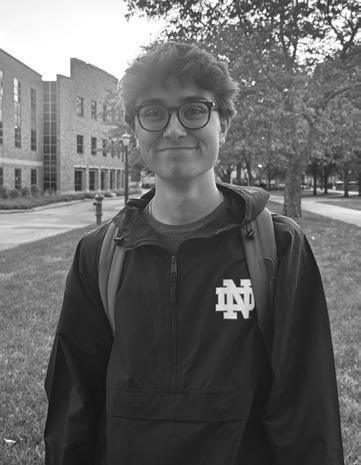
Peyton Reynolds junior Sigfried Hall “Stanford (not Keenan).”
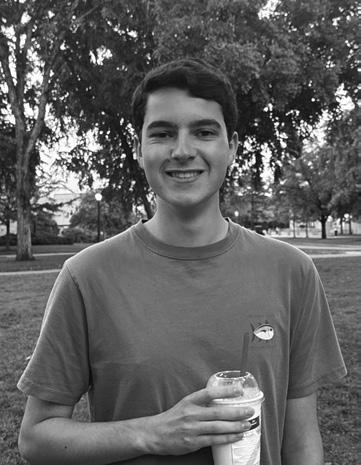
Andrew Vasta sophomore Dunne Hall
“Grace and Flanner.”
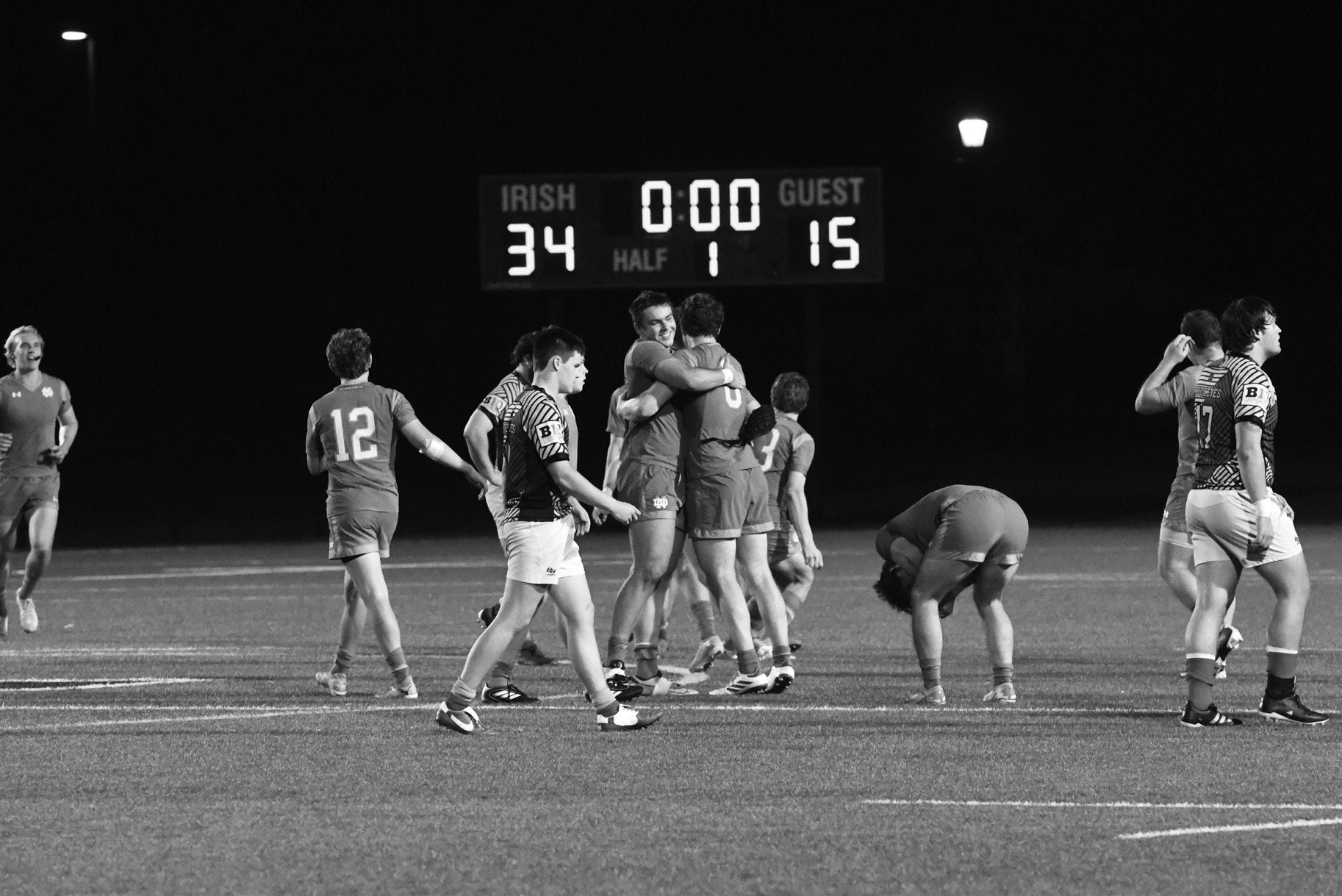
CROSSWORD | WILL SHORTZ
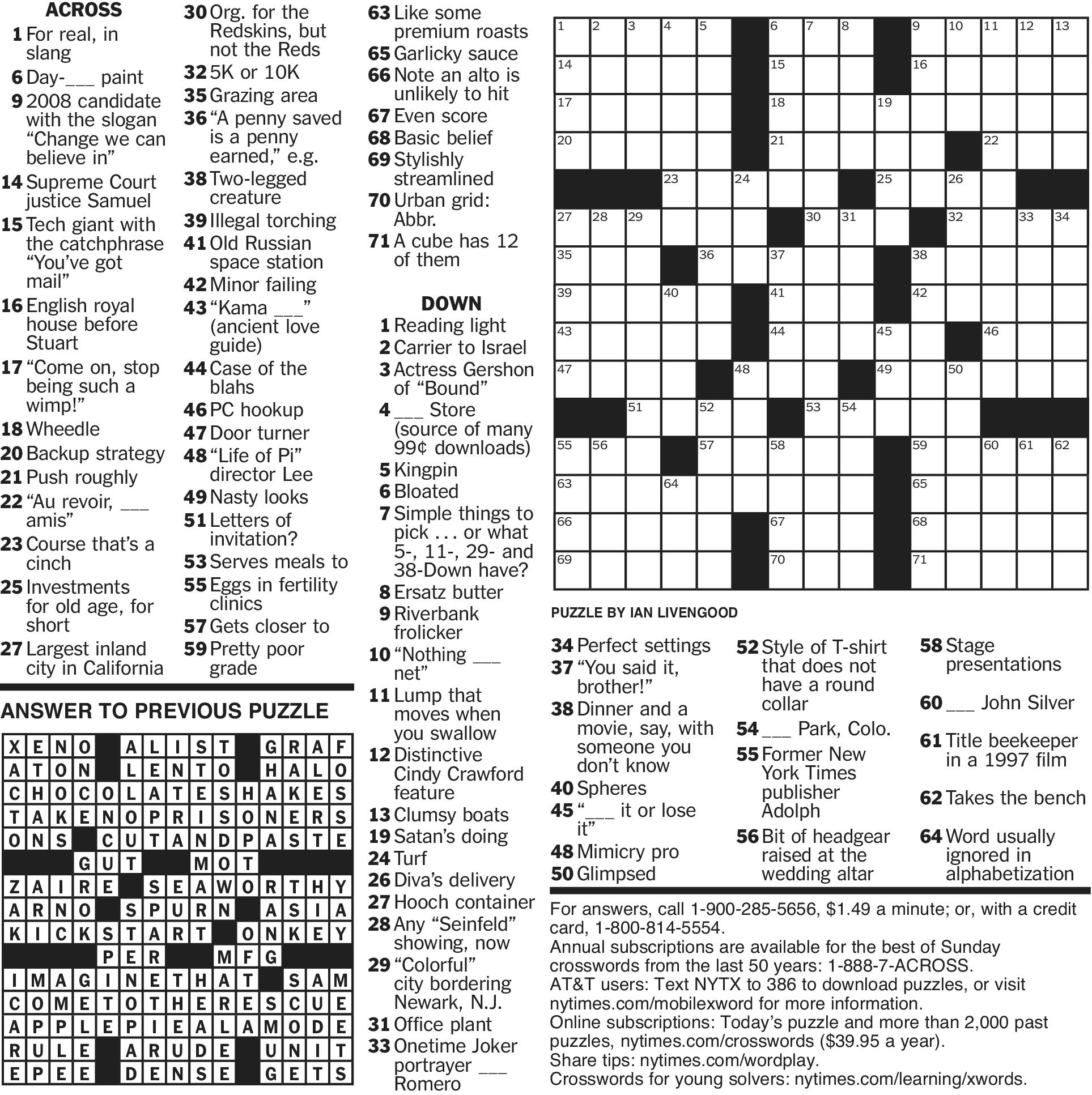
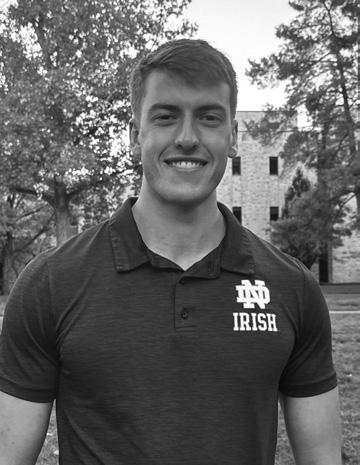
Jakob Kotz sophomore Dunne Hall
“Knott Hall.”
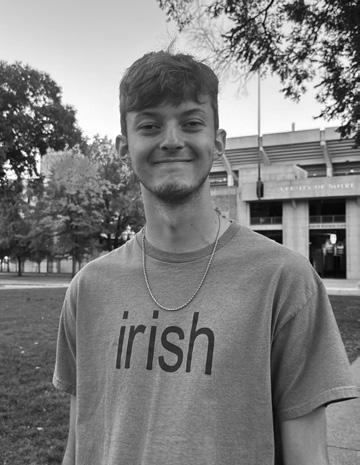
Jax Valenti sophomore Dunne Hall
“Flanner Hall.”
Have an idea for a poll? Email dstangel@nd.edu
What is your favorite rainy-day pasttime?
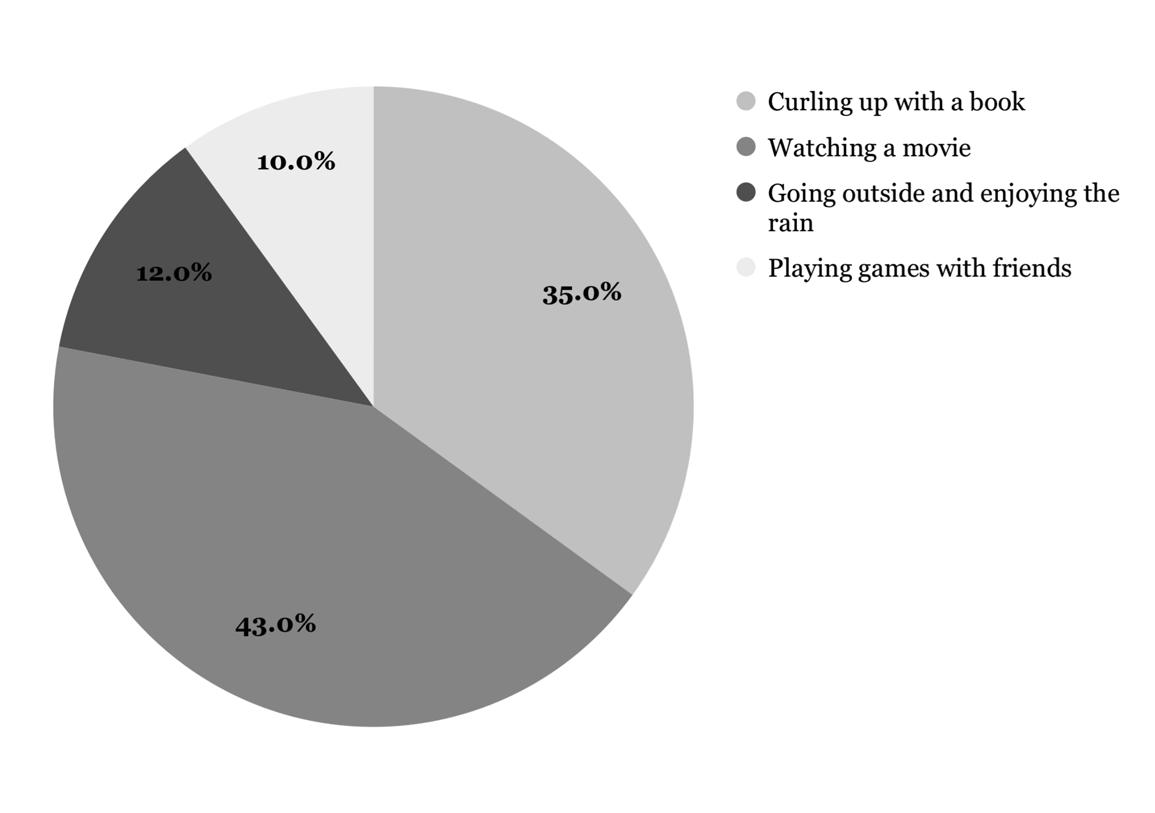
A recent poll conducted by The Observer asked students what thier favorite rainy-day pasttime was, fitting for Tuesday’s cool showers. 43% of respondents said they preferred watching movies, with curling up with a book coming in second at 35%. 12% of students said their favorite was to go outside and enjoy the rain, and 10% said that playing games with friends was their preferred way to spend a rainy day. Students will have to wait a while before enjoying these pasttimes again, though, as the forecast for the rest of the week looks sunny.
Want your event included here? Email news@ndsmcobserver.com
Wednesday
Stories of Justice from Death Row
Panel discussion with the Catholic Mobilizing Network Hesburgh Center for International Studies
4 p.m. - 5:30 p.m.
Thursday
Community Engagement Fair
Meet with 30+ local community outreach organizations Outside Geddes Hall 4 p.m. - 6 p.m.
Friday
Hope, Global Stability- and the Role of the United States A fireside chat with General Martin Dempsey 215/216 McKenna Hall 4 p.m. - 5 p.m.
Saturday
Notre Dame football vs. NC State No. 16 Fighting Irish take on the Wolfpack Notre Dame Stadium 3:30 p.m.
Sunday
Notre Dame women’s soccer vs. SMU No. 2 Fighting Irish take on the Mustangs Alumni Stadium 3:30 p.m.
By Ellie Collins Sports Writer
On the strength of relentless pressure and clinical finishing, Notre Dame jumped out to a 3-1 halftime lead on its way to a critical 4-2 victory over non-conference foe Green Bay as it prepares for a daunting final stretch of the conference season. The victory improved the Irish’s record to 7-2-3, and the Phoenix of the Horizon League dropped to 4-51. Super-sub sophomore forward Stevie Dunphy capped the first-half offensive fireworks with a literal lastsecond strike after a perfect setup on the right wing by freshman forward Ren Sylvester. The goal was wellearned, as the Irish dominated the final 35 minutes of the half after the teams exchanged goals early in the contest.
The opening score came off a beautiful corner kick by junior midfielder Nolan Spicer to the far-left post, where freshman defender Alex Rosin netted his second career goal with a great one-touch shot past Green Bay junior goalie Drew Swancutt in the 8th-minute. It marked the 11th goal of the season off of set pieces, a team strength. Green Bay quickly responded
with an impressive equalizer, as junior midfielder Noah Lechelt perfectly split Notre Dame defenders with a through ball to senior forward Chris Album in the 15th-minute. Album took advantage of a good first touch and easily finished inside the left post past helpless Irish sophomore goalie Blake Kelly.
Notre Dame returned the favor in the 18th-minute as Spicer, once again, delivered a perfect cross from the right wing, and senior forward Wyatt Borso cashed in with a header after earlier striking one off the crossbar.
Spicer continually teamed with fellow junior midfielder Wyatt Lewis to apply pressure and create opportunities for the Irish, as Notre Dame outshot Green Bay 15-3 in the first half. Over the first 20 minutes, the two-man play of Lewis and Spicer consistently put the Phoenix on their heels. “Lewis is a great player,” Spicer said, “so it’s easy to play with him out there. We’ve been working on trying to get him higher in those areas, so it’s easy. We just play off each other; we have good chemistry and then the rest of the guys just try to join in to attack. We all just try to feed off each others’ energy.”
The midfield pressure of Spicer,
Lewis, Sylvester and senior KK Baffour created consistent opportunities for an in-sync Irish offense, and its superior depth wore down Green Bay. The near-constant attack by the Irish paid dividends in the final second of the half when Sylvester set up fellow reserve Dunphy to cap the first half scoring and give the Irish an all-important two-goal cushion. “I don’t think we started slow, but we could’ve started with a little bit more intensity,” eighth-year coach Chad Riley said, “and I think their goal kind of woke us up a bit. And the response was great … The guys that came off the bench really gave us a lift and got that third goal, which was vital at the end of the half.”
The Irish continued to dominate possession in the second half, and Baffour closed out Notre Dame’s scoring with a rocket from 10 feet outside the box that bent inside the top-right post. Swancutt had no chance. He came into the game with a 3-0 record and only one goal allowed; he found things much more difficult at Alumni Stadium.
Besides the early goal, the only defensive missteps by the Irish were in the game’s final minutes, when Kelly uncharacteristically misplayed
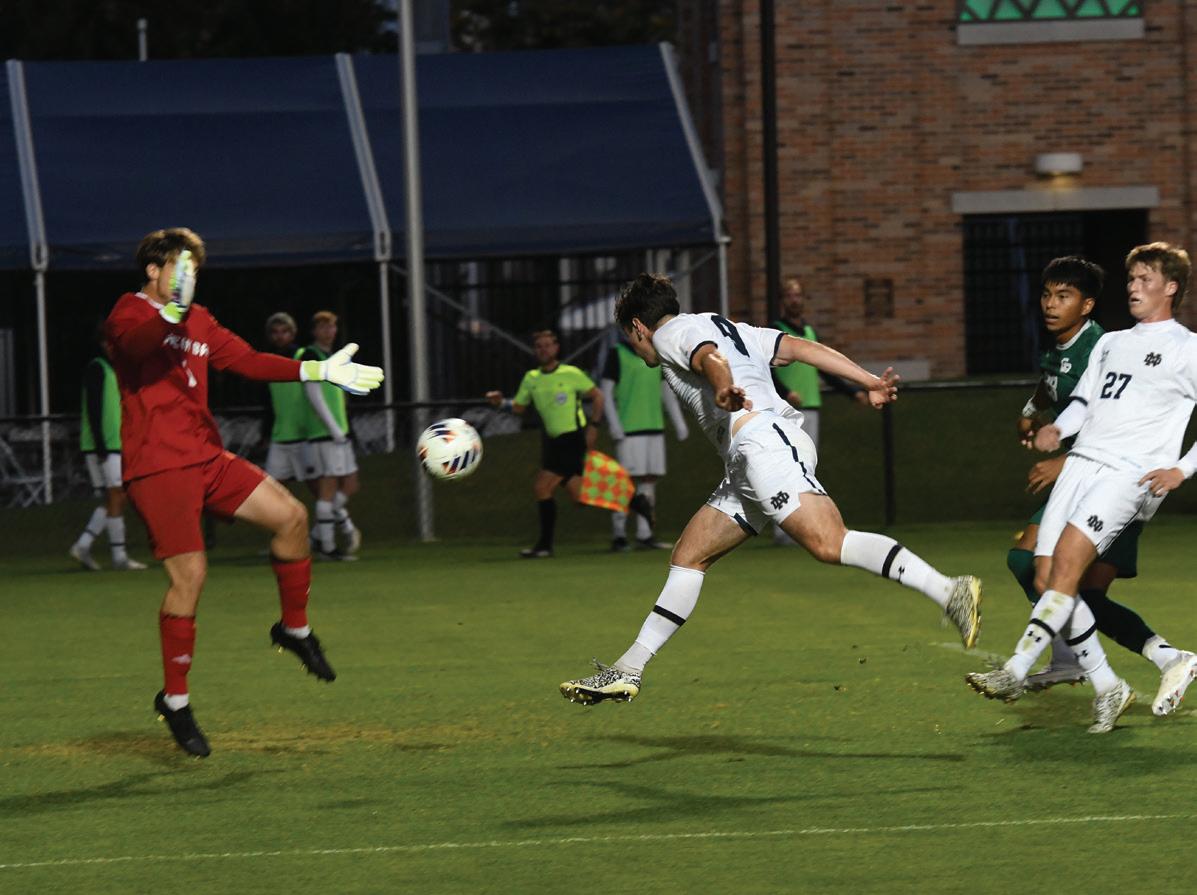
Senior forward Wyatt Borso finishes off a cross in Notre Dame’s
a shot from the far-right wing and allowed a goal by graduate forward Noah Madrigal in the 89th-minute. Then, in the 90th-minute, Kelly had to make a miraculous double save on Lechelt and junior forward Dennis Nyame.
The Irish look to continue their winning ways and reenter the national rankings in Charlottesville on Friday, Oct. 10, as they face No. 8 Virginia. The tilt begins a
challenging close to the season that also includes No. 10 NC State at home, and fellow ACC foes Wake Forest and Boston College on the road. “Now in October, the games become really important,” said Spicer, “so we knew we had to come in here and get a win and continue that the rest of the year.”
Contact Ellie Collins at ecollin9@nd.edu
By Payton Dymek Sports Writer
On Saturday, Notre Dame gained a much-needed win against the unranked Boise State Broncos 287, moving the Irish up to No. 16 in the AP Top 25 College Football Poll, just under Michigan and squeaking above Illinois.
Going into this matchup, nobody could agree on what they thought would happen. Some fans argued that it would be a high-scoring game on both sides of the line with the score coming down to any extra points the team could grasp. Others argued for a very close game, especially given Boise State’s history of upsetting top teams like Oklahoma (2007 Fiesta Bowl), TCU (2010
Fiesta Bowl) and BYU (Oct. 2021).
Despite whispers, Notre Dame put on a show for their annual “Irish Wear Green” game and extended their win streak to three straight games and improved their overall record to 3-2. Here are some of the team’s strengths and weaknesses from this past weekend:
Stock-up: special teams
For those of you who are unfamiliar, a special team is a unit made of specialized players who specifically handle different field situations such as kickoffs, punts or extra points. In this week’s press conference, Marcus Freeman stated how he believes special teams coach Marty Biagi has been doing a phenomenal job since he’s arrived at
Notre Dame, specifically highlighting his chaotic and explosive plays that have brought success for the Irish. Freeman explained how Biagi has set up a special culture around special teams where they are not overlooked. Instead, people are begging to be put in special teams, which demonstrates how competitive the talent on these teams is. Moving forwards to play a big team like NC State, it’ll come down to whose special team can outperform the other, and right now, with inconsistency and defensive injuries on the Wolfpack side, the advantage may shift toward the Irish.
Stock-up: Leonard Moore
Coming off missing the last two games due to injury, sophomore
Contact Payton Dymek at pdymek01@saintmarys.edu ND FOOTBALL
cornerback Leonard Moore was responsible for two of the four total interceptions against Boise State. Aside from interceptions, Moore had six total tackles, all of which were solo tackles, and gained four yards for the Irish defense. With Moore’s recent success against the Broncos, it’s clear that he has the opportunity and skill to surpass his numbers from last season: 48 total tackles, 16 assisted tackles and 11 passes defended, especially because this season alone he’s already gotten more interceptions than he had in the entire previous season.
Stock-down: penalties
Throughout the entirety of the game, the Irish racked up 11 infractions for 112 yards. Although they
didn’t cost Notre Dame the game, Freeman noted, “That’s something that sticks out. Way too many penalties for the team we aspire to be.” Despite some fans believing that the referees were just throwing their flags out, there’s a difference between a team having penalties that are aggressive and a team having ones that are undisciplined. However, the majority of their 11 were undisciplined like false starts and late hits. Moving forward, Notre Dame needs to clean up their penalties, and it may be better to not be as aggressive on the line and edges as they were this weekend.
By Payton Dymek Sports Writer
Despite putting up a tough fight, Saint Mary’s soccer fell to Calvin University on Saturday. The Belles came up short 5-0 and were handed their second loss of the season, making the team 6-2-2 with the Knights improving to 6-4.
The game quickly got away from the Belles as the Calvin offense wasted no time. Junior middle Mikaela Waroway scored a goal within the first eight minutes, and just two minutes later, junior
forward Avery Mrozinski found the back of the net to give the Knights a 2-0 lead before the clock even hit 10 minutes.
While Saint Mary’s tried to stay in possession of the ball, the Calvin defense was too strong and barely allowed the Belles to take any shots on goal. The Knights eventually stole the ball from Saint Mary’s, leading to another Knights goal by senior forward CeCe McCarthy. Calvin outshot the Belles 10-1 in the first half and allowed no shots on goal.
Saint Mary’s offense attempted to mirror the Knights’ quick start
after halftime; however, the Belles were met with brute defense. Calvin continued their pressure, which was only intensified by the harsh heat.
Calvin senior midfielder Elie Farrell scored a header goal five minutes into the second half, which broke the Belles’ spirit even more.
Saint Mary’s used all of their top players and attempted to get into the box, but the Knights were too strong and continued to push the Belles out every time they were close. The last goal of the game came close to the end when sophomore forward Vivian Nagelkirk successfully
landed one in the net, closing out the score 5-0.
Freshman forward Mia Johnson led Saint Mary’s with three shots and two shots on goal. Sophomore goalkeeper Keona Caraballo would make three saves after coming in for freshman goalkeeper Meghan Krayer, who left the game with an injury in the 10th minute.
The Belles will host Adrian at home this Saturday, Oct. 11 to celebrate Senior Day. Adrian is currently 3-7-1 overall and 0-1 in conference play and will be a good competitor for Saint Mary’s.
The Bulldogs boast players such as senior forward Annamarie Fosmoen who currently has five goals on the season with 26 shots on goal, and senior defender Teagan Bergeron who follows with two goals and seven shots on goal. Defensively, Adrian is led by senior goalkeeper Katelyn Stanton who has 54 saves on the year and a save percentage of 0.844. Kickoff is at 12:30 p.m. at Purcell Athletic Fields.
Contact Payton Dymek at pdymek01@saintmarys.edu
By Chris Dailey Sports Writer
The No. 2 Notre Dame women’s soccer team will play host to No. 5 Florida State this Thursday at Alumni Stadium. Kickoff is set for 7 p.m. in what’s expected to be one of the premier games of the college soccer season.
Led by the 12 goals of AllAmerican sophomore Izzy Engle – a mark that places her third in the country – Notre Dame has soared to an undefeated 10-0-1 record and are seen as College Cup favorites. Engle’s exemplary play has been complemented by classmate Anabelle Chukwu. The Canadian international, splitting time between forward and midfield, has scored eight goals and dished out two assists.
Chukwu’s hat trick propelled the Irish to a 3-0 victory over Michigan State in early September, and she has provided a point in all but four games this season.
Engle and Chukwu were both recently named to the Mac Hermann Trophy Watch List, alongside senior defender Leah Klenke. Klenke’s willingness to join the attack has proved successful for head coach Nate Norman’s team. Her presence has created
overloads that opposing defenses have struggled to deal with.
Through 11 games, the Irish have scored a blistering 39 goals. Alongside the talented attacking tandem of Engle and Chukwu is fellow sophomore Ellie Hodsden. A menacing forward herself, Hodsden has notched five goals.
Altogether, the Irish’s three main goal-scorers combine for 25 of the team’s 39 goals.
Norman will rely on the Irish’s stars to come up big once again as they square off against a Seminoles team that has been on a tear. Also undefeated, Florida State has accumulated a nearperfect 8-0-2 record. They have recorded several big ACC wins, most notably a 1-0 win on the road at No. 18 North Carolina.
At the forefront of the Seminoles’ attack is sophomore Wrianna Hudson. Despite starting only five games, Hudson has notched eight goals. Junior Jordynn Dudley has also thrived — to the surprise of none. Named the Most Outstanding Offensive Player in the 2023 NCAA Tournament, Dudley was the heart and soul behind the Seminoles’ National Championship two seasons ago.
The two teams have a similar
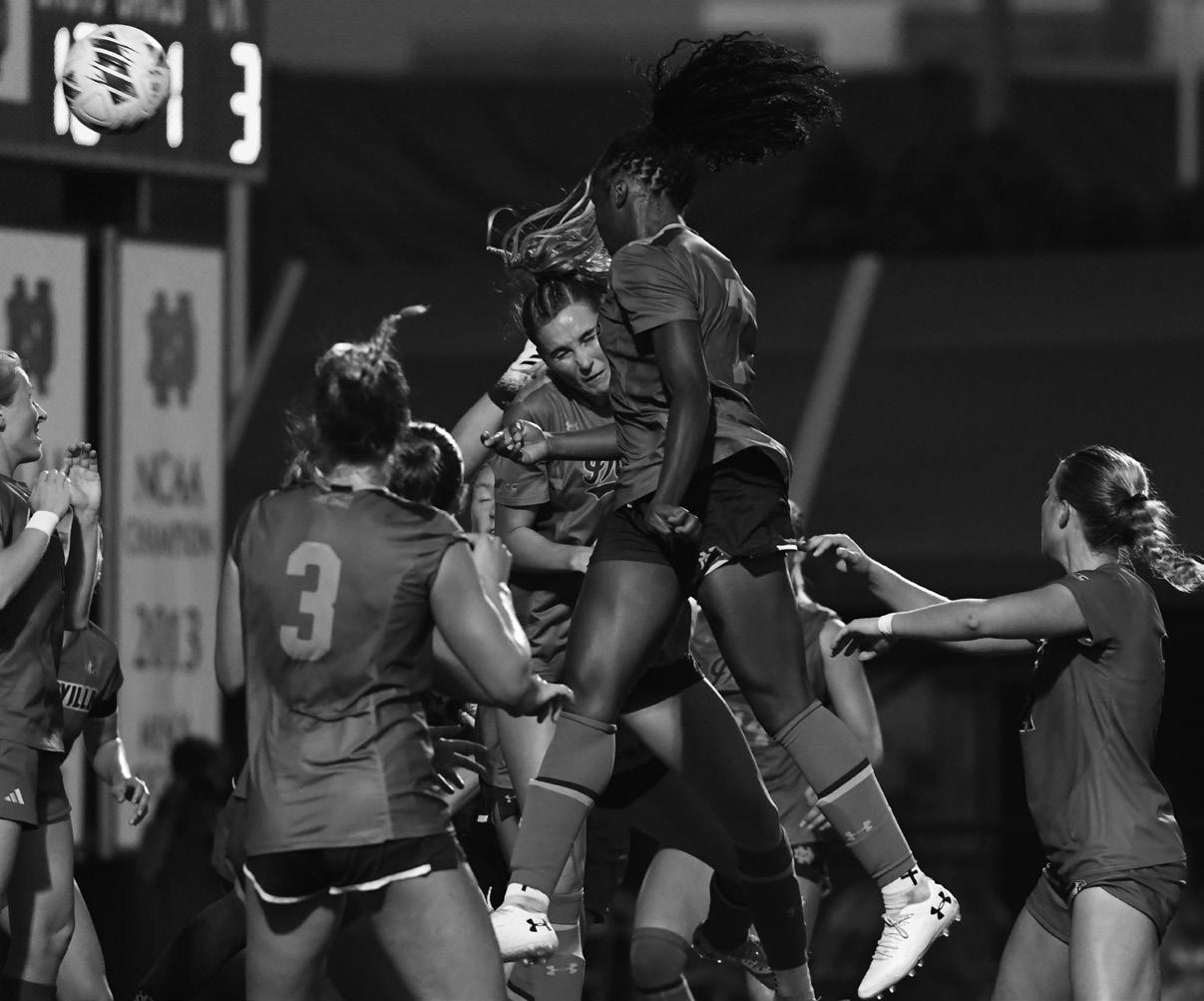
profile: an undefeated record and immensely talented attackers. Notre Dame’s lone tie this season came on the road to No. 6 Arkansas. In a humid August fixture, the Irish battled for the full 90 against one of the SEC’s most elite programs.
As for Florida State, their season has followed a similar path. They’ve recorded marquee instate wins against the likes of
PAID ADVERTISEMENT
Florida, Stetson and FAU and they’ve failed to claim all three points just twice. Those two matches were against Kansas and NC State. Both were 1-1 scorelines.
Important to note, those two goals allowed are the only Florida State have conceded all season.
But, somehow, that’s not even the Seminoles’ most impressive stat.
That distinction belongs to the fact that Florida State’s last loss
came on Oct. 6 of last season.
Although Florida State was upset by Vanderbilt in the NCAA Tournament Second Round, the match was decided in penalties and is thus recorded as a draw in the final record book.
If the Irish are to take three points from this match, they’ll retain their position atop the ACC table. Coming into the match with a 5-0 record, Notre Dame’s 15 points are two ahead of the Seminoles. If the Seminoles win, they will jump Notre Dame.
While there is uncertainty regarding who will end up as the top side in the ACC, one thing is clear: Notre Dame is hungry for a win. After stumbling to Florida State 2-1 in the ACC quarterfinals a season ago, the Irish are eager for revenge.
Between the Irish big-three of Engle, Chukwu and Klenke and Florida State’s playmakers in Hudson and Dudley, Thursday night will be a battle of the stars. The match from Alumni Stadium will be nationally broadcast on the ACC Network and admission is free.
Contact Chris Dailey at cdailey2@nd.edu

By Jack Muething Sports Writer
The Notre Dame offense put up their second lowest total number of points last Saturday against Boise State in their 28-7 win. That being said, they had set the bar pretty high scoring over 40 points in three of their five games. Today, we grade each offensive position group’s performance in that win against the Broncos.
Quarterback
Saturday’s game was the first time this season that redshirt freshman CJ Carr did not eclipse 200 passing yards in a game, but he still got pretty close. His final statline was 15/23 for 189 yards and two touchdowns. The one glaring mistake he made was overthrowing to a wide-open Will Pauling on fourthand-8 for what would have been a sure touchdown. The deep ball also wasn’t there from his game as the longest pass he made was only 24 yards.
But while his play wasn’t exactly exceptional, it’s important to note that Carr didn’t turn the ball over once. In fact, he hasn’t thrown an interception since the game against Texas A&M. He also isn’t going to receive much credit for the fact that he led his team down to the 1-yard line on the opening drive of the game. He continued to make incredibly smart decisions with the football, and on a day where he didn’t have his best stuff, he still played a very solid game of football and put the Irish in spots where they could win.
Weekly grade: “B.” Season grade: “A-.”
Running backs
It is not a stretch to say that the Irish have the best running back duo in the country. Against Boise
State, both juniors Jeremiyah Love and Jadarian Price were excellent once again. Love rushed the ball 16 times for 103 yards and a touchdown while also catching a pass for 11 yards, shining especially on the team’s two touchdown drives in the first half. As a team, the Irish combined for 144 yards on those two drives. Love accounts for 86 of the 144 total yards on those drives, and he picked up the touchdown on that final scoring drive of the first half that gave the Irish back the lead and momentum. The Irish went into that drive needing points desperately, and Love delivered once again. It’s no coincidence that the drives where the Irish found the most success in the first half were the ones where Love was the anchor.
Price put together a statline of eight rushes for 83 yards and a touchdown. While the spotlight in the first half belonged to Love, Price was the best out of the two in the second half. Price has had many impressive runs this season, and the one he had for the team’s fourth touchdown on Saturday is among the best of them. He broke four tackles on his way to the end zone for a 49-yard touchdown. His ability to break tackles and use his strength to create big plays is what makes him so good, and that run was a great example of that. Price continues to do the most he can with the opportunities he gets, and this two-headed monster in the backfield combined for 197 total yards and propelled this team to another victory.
Weekly grade: “A-.” Season grade: “A.”
Junior Jordan Faison continued his stellar play with a great game against Boise State, picking up six receptions for 83 yards, leading the team in both stats. He has been
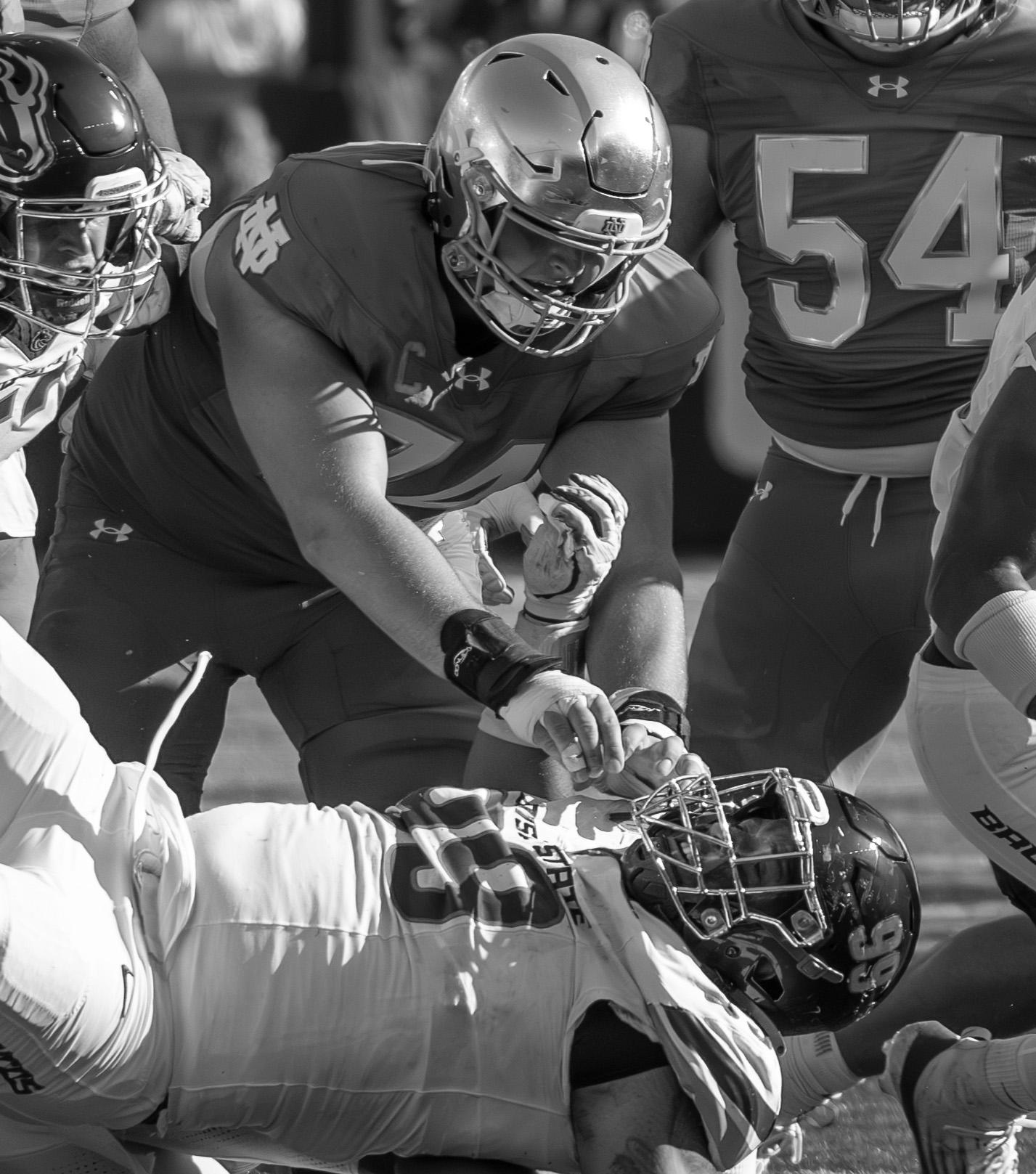
Carr’s main go-to guy this season, and while senior Malachi Fields caught the touchdown pass on the team’s lone possession in the third quarter, Faison had four catches and accounted for 31 yards on the team’s methodical 10-play, 79-yard drive to make it a two-possession lead.
The man who caught the touchdown on that drive, Fields, also continued his excellent play, putting together four catches for 44 yards and that touchdown. He has continued to be an excellent receiver in one-on-one situations, and his touchdown in that game was an example of that. Some would argue he scored on the play before, but he was still able to pick up yards on that play by drawing a pass interference call, and then obviously scored on the
play after.
Additionally, even though he only had two catches, senior Will Pauling put together a solid game as well, picking up 43 yards, including a 24yard touchdown catch to open the scoring for the Irish. He also caught the pass on the two-point conversion attempt at the end of the first half. After quiet games to begin the season, he seems to have come into his own and established a rapport with Carr.
The main difference between this game and others was that those were the only three to get on the statsheet out of the wide receivers. Though junior Jaden Greathouse was inactive, freshman Micah Gilbert and sophomore KK Smith were very limited in this game, and the Irish truly excel
when they are able to get many different guys involved. It wasn’t the Irish’s best game of the year receiving wise, but they still put together a very solid effort.
Weekly grade: “B.” Season grade: “B+.”
Senior Eli Raridon only mustered two catches for eight yards against Boise State. His big gain of the day was wiped away by an offensive pass interference call on him. He started the year with two excellent games in the losses against Miami and Texas A&M, but since then, it’s been hard for him and any other tight end to get much going. Junior Cooper Flanagan has returned to practice this week, though, after tearing his Achilles against Georgia in the playoffs last season, so this group could take a step up in future weeks. Their performance against Boise State was a bit of a disappointment, however.
Weekly grade: “C-.” Season grade: “B.”
This was the first game of the season where Carr did not get sacked once. Additionally, the run blocking has been very impressive since that Miami game, and it continued here. Additionally, they only accounted for three of the 11 penalties called against the Irish this week. Only one of those was a holding call. Though the competition has been weaker these past few weeks, the line just looks more comfortable as a unit. They have only gotten better as the year has gone on, and this game was their best of the year.
Weekly grade: “A-.” Season grade: “B-.”
Contact Jack Muething at jmuethin@nd.edu
By John Keyes Sports Writer
Notre Dame’s defense finally held an opponent to single digits this past weekend against Boise State after starting off the year allowing 27, 41, 30 and 13 points respectively to their previous opponents. Coming off last year, Irish fans had high hopes for the returning defense. Through the first four games of the season, those expectations were not met. This past weekend against Boise State definitely marked Notre Dame’s best defensive performance so far, and they will be looking to build off that heading into this Saturday’s showdown with the NC State Wolfpack.
Secondary
The return of sophomore cornerback Leonard Moore against Boise State was definitely noticeable. Moore led Notre Dame’s secondary
with the first two interceptions of the game, and the defense ended up eclipsing two more in the 28-7 win. Freshman safety Tae Johnson and junior safety Luke Talich both tallied late interceptions to join Moore on the pick train. Sophomore safety Adon Shuler also contributed seven tackles. The Notre Dame secondary has been waiting to come alive this season after so much success last year, and against Boise State they finally made their mark. The back half forced Boise State junior quarterback Maddux Madsen to throw four interceptions and only accumulate 215 passing yards on an aggressive 37 passing attempts. This was a great defensive performance against a quarterback who helped lead his team to the College Football Playoff last year. For the rest of the season, the secondary will look to build off of this performance and continue to give passing attacks trouble.
Weekly grade: “A.” Season grade: “B.”
The defensive line also did their part to hold Boise State to only seven points. The defensive line helped to generate four sacks, the most sacks the Notre Dame defense recorded in a game thus far this season. Not only did the defensive line slow down Madsen, but they also did their part in containing the rush, holding Boise State to only 100 rushing yards on a whopping 34 attempts. Senior defensive linemen Jordan Botelho and sophomore defensive lineman Boubacar Traore led the line with four tackles each. The pressure that the defensive line provided all game is the same energy that will be expected of them for the rest of the year.
Weekly grade: “A-.” Season grade: “B.”
The linebackers also contributed in more than one way to the defense having their best showing of the campaign. Notre Dame linebackers are historically relied on to lead the defense and make big plays on both passing and rushing plays. Against the Broncos, they appeared to be the leaders once again. Sophomores Kyngstonn Viliamu-Asa and Jaiden Ausberry each tallied eight tackles, leading the way for the Notre Dame defense. Not only did the defense have four sacks, but they also had two pass deflections. It was clear all Saturday afternoon that the linebackers were in control of the game, constantly forcing Madsen to make a quick throw or scramble out of the pocket. Junior linebacker Drayk Bowen has been a leader for Notre Dame’s linebacker group and he had a versatile stat line on Saturday with five tackles and a sack. There were still some missed tackles and
opportunities for the linebackers, but, like the other position groups, things definitely seem to be steadily improving.
Weekly grade: “A-.” Season grade: “B+.”
Freshman kicker Erik Schmidt had a PAT blocked early on in the game, but that was his first missed PAT of the season. Junior kicker Marcello Diomede made both extra points that he attempted against Boise State, tallying his first points of the season for the Notre Dame kicking unit. Special teams didn’t play a huge role in this game, but down the stretch of the season Notre Dame’s kicking unit will definitely be expected to perform.
Weekly grade: “B+.” Season grade: “B.”
Contact John Keyes at jkeyes2@nd.edu